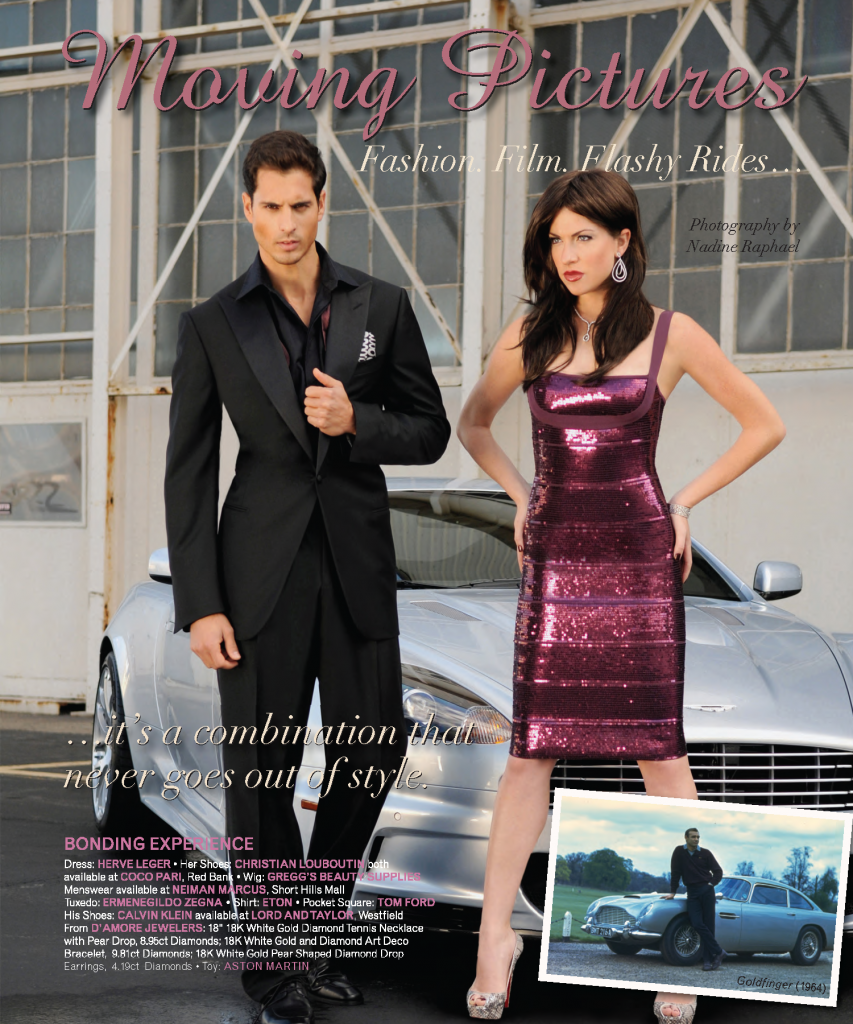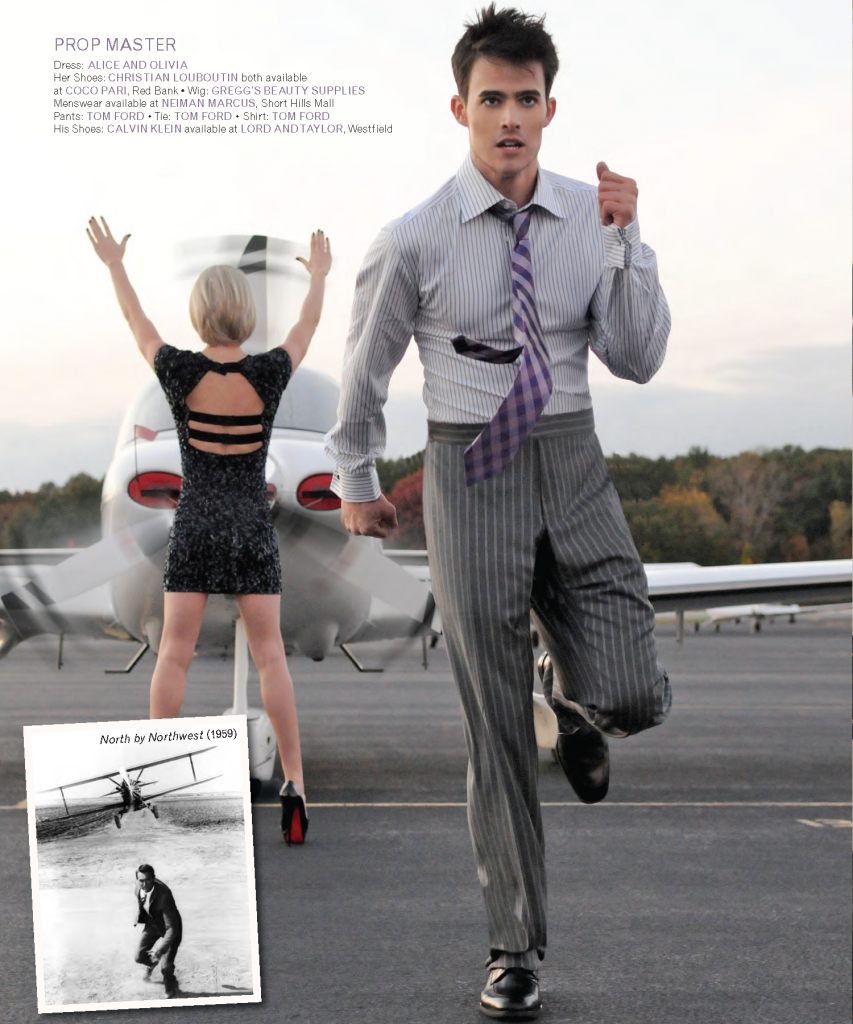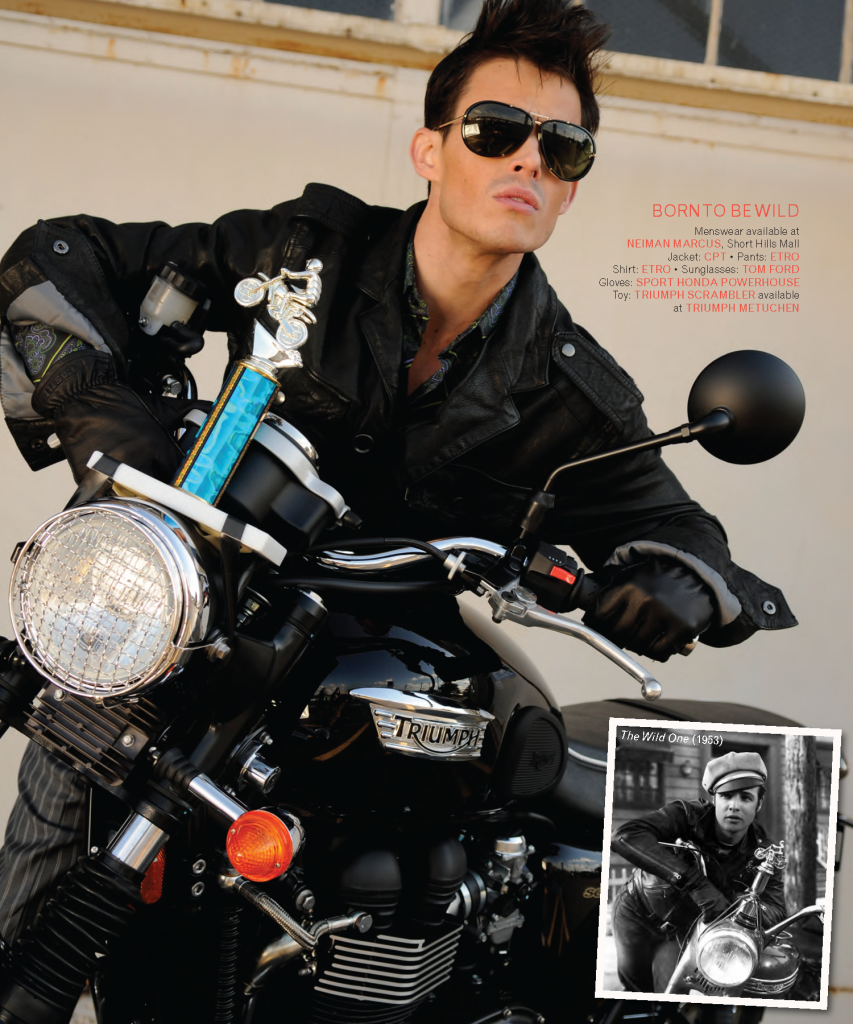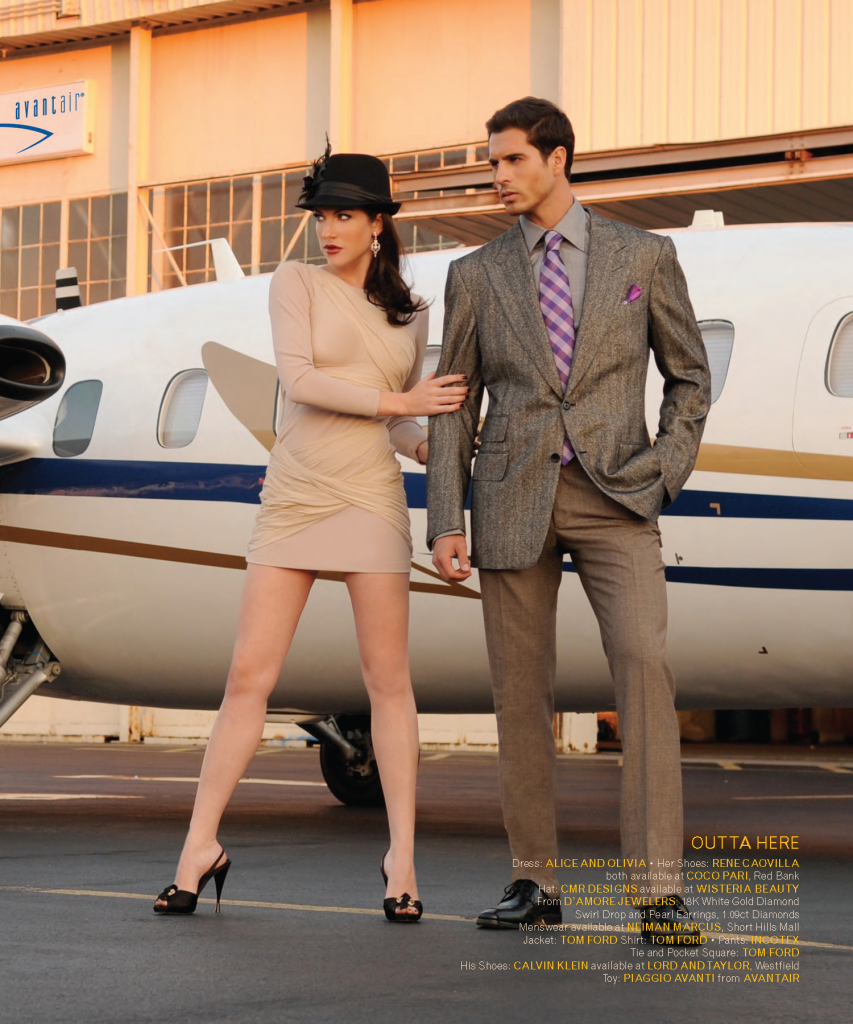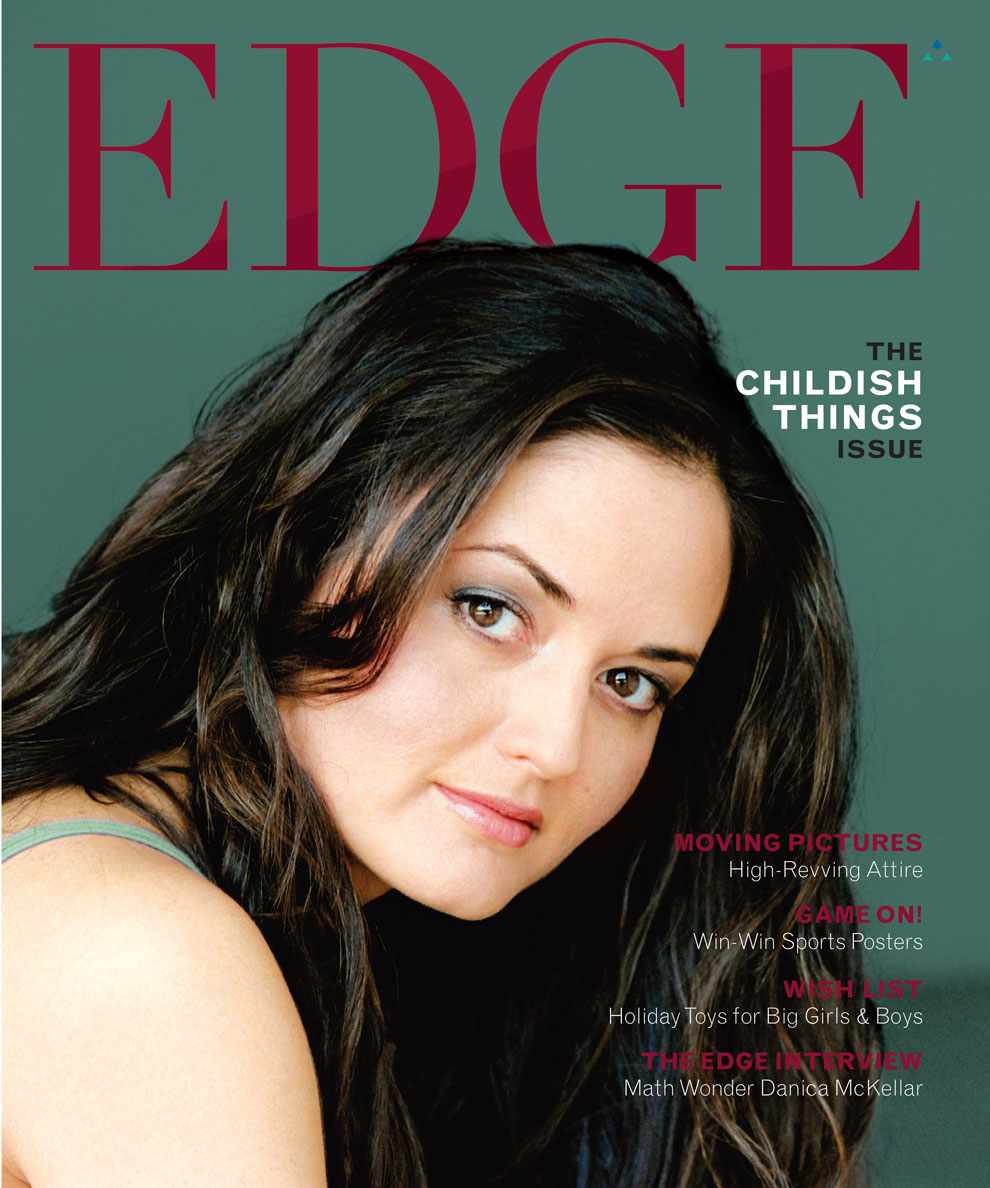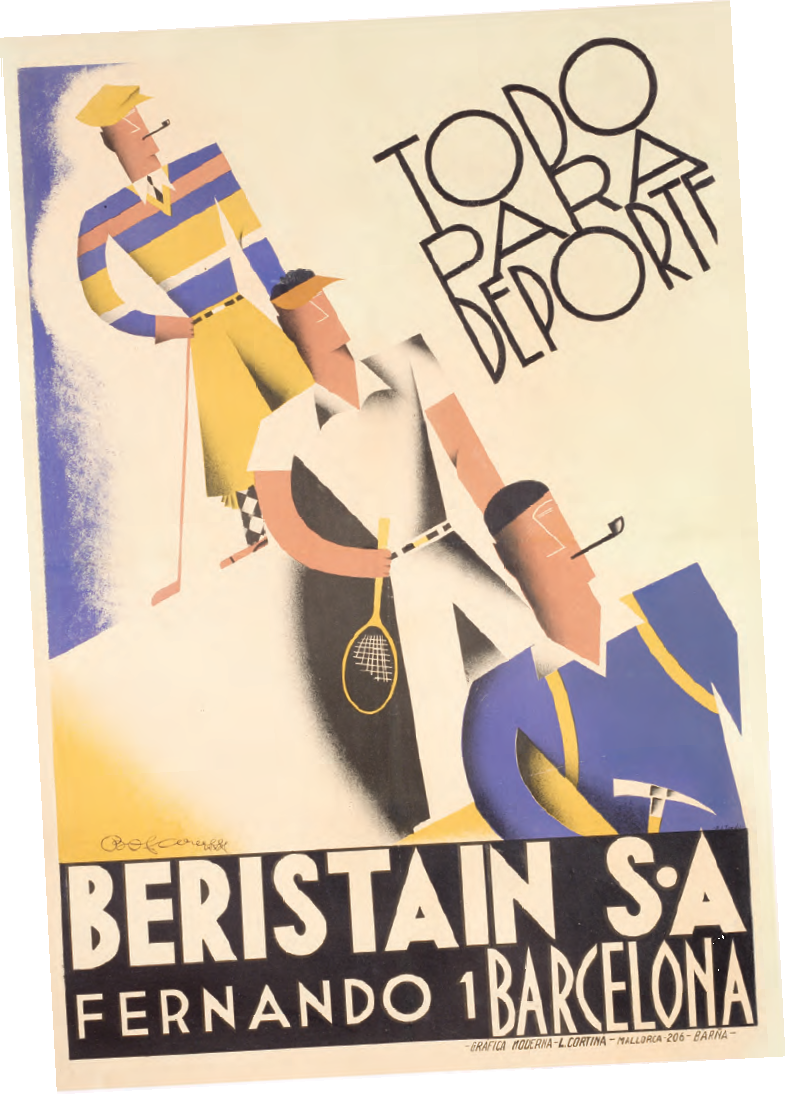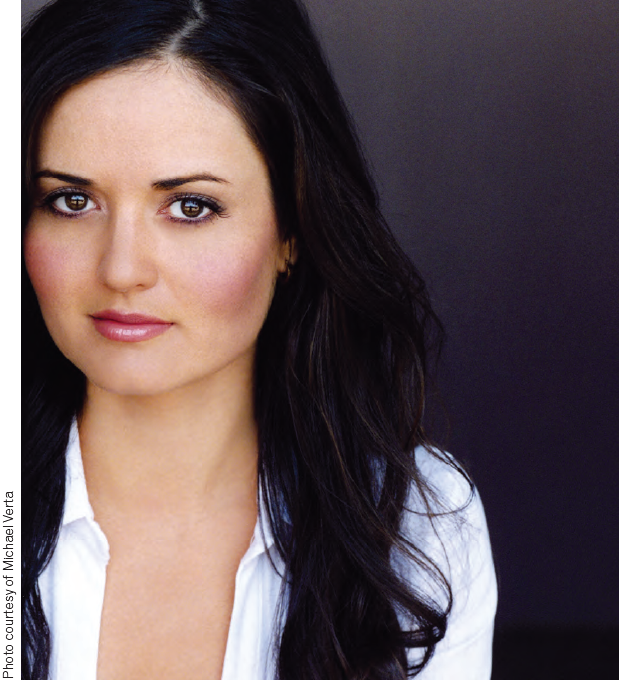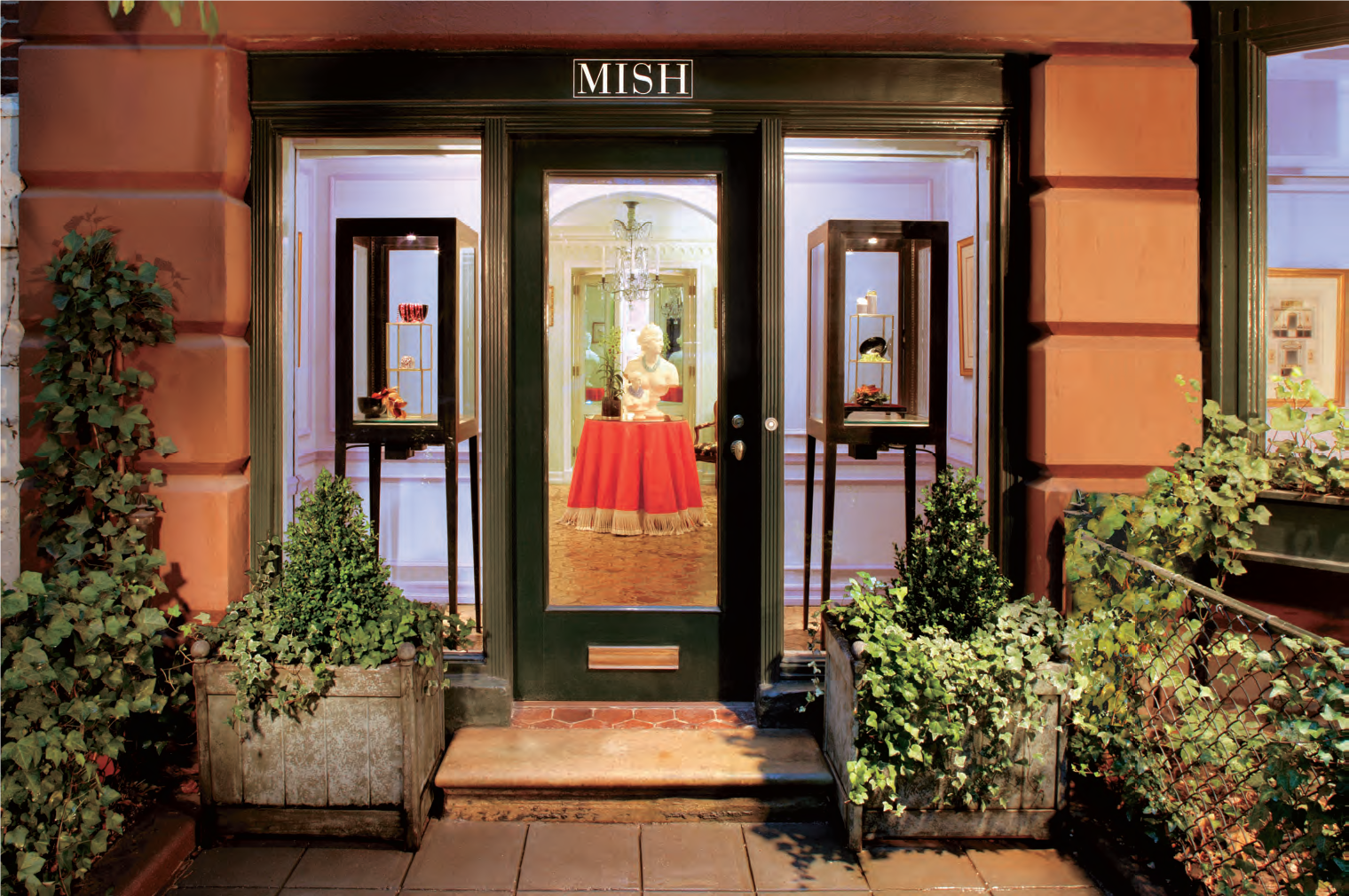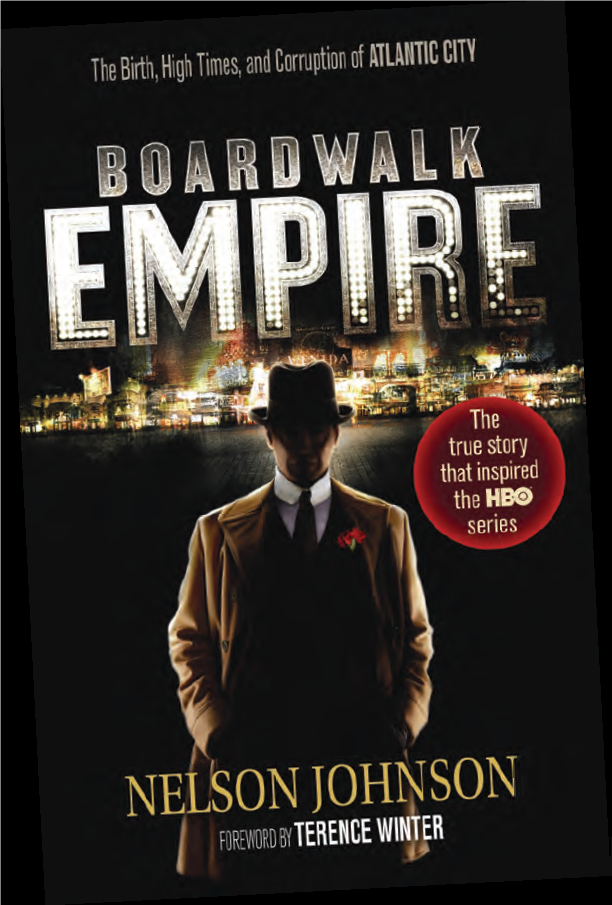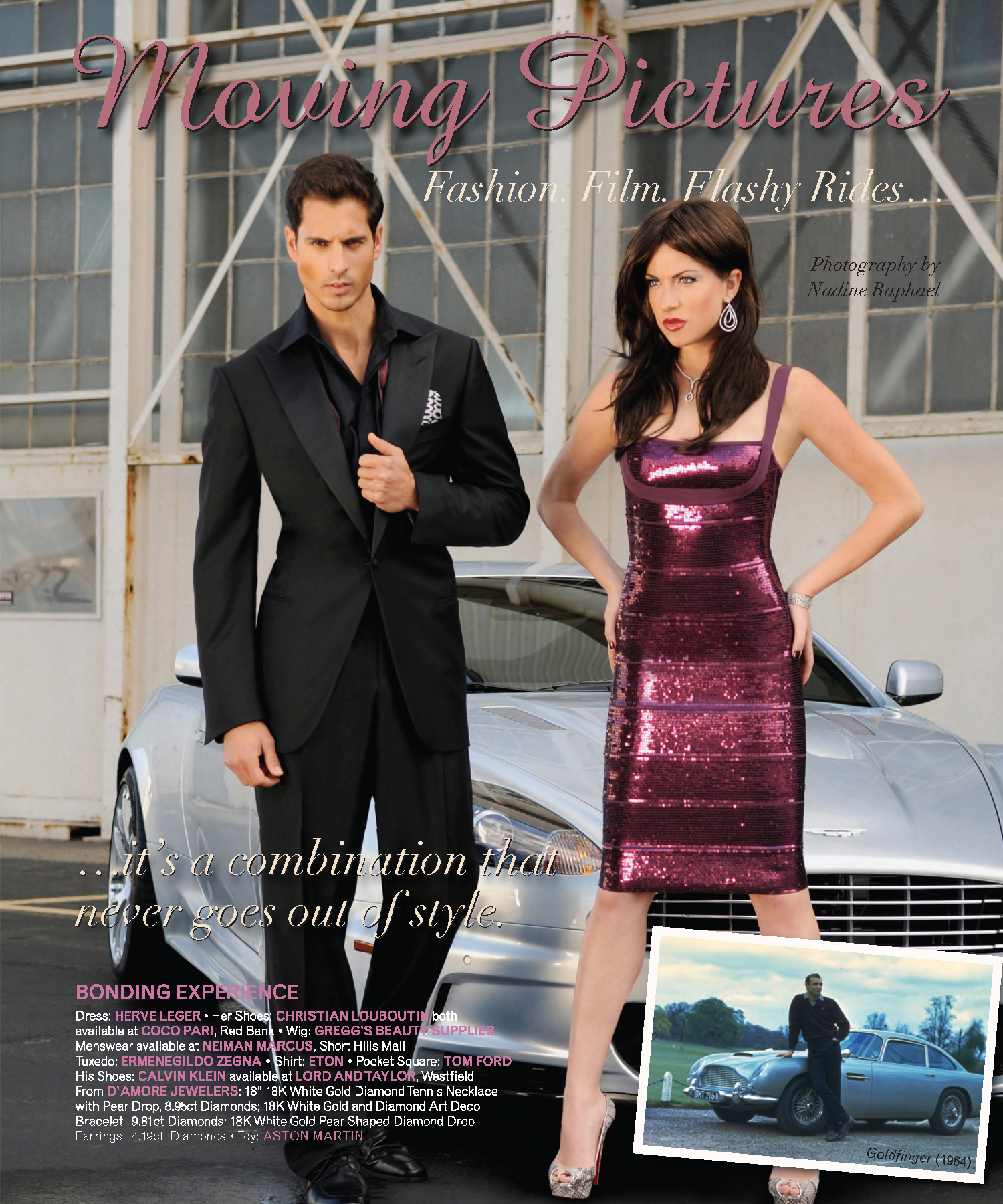“This BYOB is crowded from the ring of the dinner bell ‘til last call from the kitchen.”
The Italian Pantry Bistro hits a trifecta of buzzwords for comfort in its name. Italian as a genre is the feel-good food of choice for many. Pantry is where all that good stuff in the kitchen is stored. Bistro signifies a down-home, hu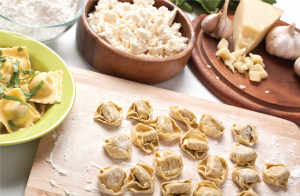 mble restaurant where local favorites are served. Frank Rizzo, chef-owner of The Italian Pantry Bistro, follows through on all the promises made in the restaurant’s name on his menu—in his cooking and in the attitude set forth in this small, near-Spartan storefront in downtown Cranford. “Comfort” may have become a gastronomic cliché, yet Rizzo and his crew disregard it as a sound-bite and wend their way around its possibilities with confidence and a smack of creativity. All that makes Italian Pantry a fun place to dig in to hearty grub. Which is why this BYOB is crowded from the ring of the dinner bell ’til last call from the kitchen. And why families, kids in tow, can be spotted doing early-shift eating—and couples catching a casual-dress date night knock wineglasses in twosomes and foursomes later on. For all its popularity in Union County, it flies under the radar of many of New Jersey’s restaurant groupies. That might be because it is devoted to the now-rather-passé Comfort Food category. Yet I’d bet a bite of sage-tinged French toast, in full fall regalia with the flavors of poached pear, red onion and a pungent blue cheese sauce, might tempt those trackers of trends. I know the baby-back ribs could stand against anything a destination barbecue shack in the South might be dishing up. You could rack up the clichés describing them—falling off the bone, licked with sauce neither too tart nor too sugared—but the point is the sincerity of the preparation. And, absolutely, the pert, moist, just-shy-of-sturdy cornbread served on the side. You could spend a lot of time wondering why you might never before have come across a sweet potato dumpling. Gently kneaded flour-water dough is plied into myriad shapes and stuffed with all manner of fillings the world over, but the marriage of petite fried turnover and mashed sweet potato is rare. It shouldn’t be. Especially if a swirl of chive oil is used as a spirited accent as it is here. Crunchy calamari with a tomato fondue reads like a signature dish for a restaurant called The Italian Pantry Bistro. But it was the weak link in the opening rounds, with too-tough squid giving off too much frying oil and a dipping sauce that needed to pack more of a spice punch. You’ll expect—and you’ll get—burgers, pizzas and pastas in this hometown-proud spot. But there’s always a twist, or a hint of something extra. It might be a “Buffalo”-style burger paying homage to that city’s famous Anchor Bar wings, slathered as it is with blue cheese. Or a beefy patty that’s another trip to the South, with Tennessee bacon, mushrooms, onions, Cheddar and a slap of that excellent house barbecue sauce. There’s a hint of truffle oil, a substance I usually dread, in the mix, but it’s a background note. Personal-size (jumbo personal-size, th
mble restaurant where local favorites are served. Frank Rizzo, chef-owner of The Italian Pantry Bistro, follows through on all the promises made in the restaurant’s name on his menu—in his cooking and in the attitude set forth in this small, near-Spartan storefront in downtown Cranford. “Comfort” may have become a gastronomic cliché, yet Rizzo and his crew disregard it as a sound-bite and wend their way around its possibilities with confidence and a smack of creativity. All that makes Italian Pantry a fun place to dig in to hearty grub. Which is why this BYOB is crowded from the ring of the dinner bell ’til last call from the kitchen. And why families, kids in tow, can be spotted doing early-shift eating—and couples catching a casual-dress date night knock wineglasses in twosomes and foursomes later on. For all its popularity in Union County, it flies under the radar of many of New Jersey’s restaurant groupies. That might be because it is devoted to the now-rather-passé Comfort Food category. Yet I’d bet a bite of sage-tinged French toast, in full fall regalia with the flavors of poached pear, red onion and a pungent blue cheese sauce, might tempt those trackers of trends. I know the baby-back ribs could stand against anything a destination barbecue shack in the South might be dishing up. You could rack up the clichés describing them—falling off the bone, licked with sauce neither too tart nor too sugared—but the point is the sincerity of the preparation. And, absolutely, the pert, moist, just-shy-of-sturdy cornbread served on the side. You could spend a lot of time wondering why you might never before have come across a sweet potato dumpling. Gently kneaded flour-water dough is plied into myriad shapes and stuffed with all manner of fillings the world over, but the marriage of petite fried turnover and mashed sweet potato is rare. It shouldn’t be. Especially if a swirl of chive oil is used as a spirited accent as it is here. Crunchy calamari with a tomato fondue reads like a signature dish for a restaurant called The Italian Pantry Bistro. But it was the weak link in the opening rounds, with too-tough squid giving off too much frying oil and a dipping sauce that needed to pack more of a spice punch. You’ll expect—and you’ll get—burgers, pizzas and pastas in this hometown-proud spot. But there’s always a twist, or a hint of something extra. It might be a “Buffalo”-style burger paying homage to that city’s famous Anchor Bar wings, slathered as it is with blue cheese. Or a beefy patty that’s another trip to the South, with Tennessee bacon, mushrooms, onions, Cheddar and a slap of that excellent house barbecue sauce. There’s a hint of truffle oil, a substance I usually dread, in the mix, but it’s a background note. Personal-size (jumbo personal-size, th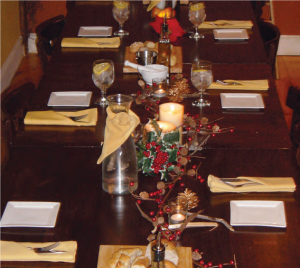 at is) pizzas (here, called pizzettas) aren’t the corner takeout kind. We took to the potato-onion-mascarpone pie, loving its charred crust and light-on-the-toppings style. I would’ve liked it even more with a more generous sprinkle of big-flake sea salt. Something to think about. That pizzetta offered a better use of the spud than the potato gnocchi, which weighed heavy in a terrific pumpkin beurre fondue sporting crispy fried sage leaves. That combo of high-fall pumpkin and butter has potential galore. You’ll see another riff on often-tired comfort fare in Rizzo’s chicken pot pie, which is topped with cornbread instead of either pastry or biscuit. It has all the usual suspects within (chicken chunks, mushrooms, peas, carrots) and a soothing gravy to bind it all together. Johnny Blue mussels, however, are anything but predictable. This season, the kitchen’s playing the pumpkin theme big, and it sets the bivalves in a startling sauce of pumpkin dotted with flecks of cranberries. It seems discordant at first, that swash of mildly sweet sauce with mussels, but there’s something funky and fun about the pairing. And the stand-up fries on the side don’t mind the frivolity. You guessed right: There’s a cupcake on the dessert menu. On this night, it’s a mini sweet potato number dressed in toasted marshmallow frosting. It’s fit for Thanksgiving. I had to laugh, eating one, as I imagined Rizzo and his kitchen team devising it as a spoof to all those marshmallow-topped sweet potato casseroles on holiday tables. Less satisfying was a baked apple dumpling that lacked substantial apple presence and seemed to try to compensate with too much walnut-raisin stuffing and a burst of butterscotch sauce. But a well-balanced poached pear crème brulée with a properly crusted top hit its stride, and the high mark for finales. The Italian Pantry Bistro is a neighborhood restaurant with a voice. It’s deliberately modest and humble, like many storefront BYOBs, but it doesn’t run with the pack by playing it safe with familiar dishes. No, instead, Italian Pantry spins comfort in a way that makes it impossible to take the genre for granted. EDGE
at is) pizzas (here, called pizzettas) aren’t the corner takeout kind. We took to the potato-onion-mascarpone pie, loving its charred crust and light-on-the-toppings style. I would’ve liked it even more with a more generous sprinkle of big-flake sea salt. Something to think about. That pizzetta offered a better use of the spud than the potato gnocchi, which weighed heavy in a terrific pumpkin beurre fondue sporting crispy fried sage leaves. That combo of high-fall pumpkin and butter has potential galore. You’ll see another riff on often-tired comfort fare in Rizzo’s chicken pot pie, which is topped with cornbread instead of either pastry or biscuit. It has all the usual suspects within (chicken chunks, mushrooms, peas, carrots) and a soothing gravy to bind it all together. Johnny Blue mussels, however, are anything but predictable. This season, the kitchen’s playing the pumpkin theme big, and it sets the bivalves in a startling sauce of pumpkin dotted with flecks of cranberries. It seems discordant at first, that swash of mildly sweet sauce with mussels, but there’s something funky and fun about the pairing. And the stand-up fries on the side don’t mind the frivolity. You guessed right: There’s a cupcake on the dessert menu. On this night, it’s a mini sweet potato number dressed in toasted marshmallow frosting. It’s fit for Thanksgiving. I had to laugh, eating one, as I imagined Rizzo and his kitchen team devising it as a spoof to all those marshmallow-topped sweet potato casseroles on holiday tables. Less satisfying was a baked apple dumpling that lacked substantial apple presence and seemed to try to compensate with too much walnut-raisin stuffing and a burst of butterscotch sauce. But a well-balanced poached pear crème brulée with a properly crusted top hit its stride, and the high mark for finales. The Italian Pantry Bistro is a neighborhood restaurant with a voice. It’s deliberately modest and humble, like many storefront BYOBs, but it doesn’t run with the pack by playing it safe with familiar dishes. No, instead, Italian Pantry spins comfort in a way that makes it impossible to take the genre for granted. EDGE
 The Italian Pantry Bistro 13 Eastman St., Cranford 908.272.7790 Open from 11:30 a.m. to 9 p.m. Tuesday through Thursday, from 11:30 a.m. to 10 p.m. Friday and Saturday, and from 5 to 9 p.m. Sunday. Closed Mondays. Reservations accepted for Sunday, Tuesday through Thursday only; it’s first-come, first-served on Fridays and Saturdays. All major credit cards accepted. BYOB. Appetizers generally range from $8 to $14, burgers $13 to $14, pizzas from $9 to $14 and pastas $20 and up. Entrees are $22 to $32.
The Italian Pantry Bistro 13 Eastman St., Cranford 908.272.7790 Open from 11:30 a.m. to 9 p.m. Tuesday through Thursday, from 11:30 a.m. to 10 p.m. Friday and Saturday, and from 5 to 9 p.m. Sunday. Closed Mondays. Reservations accepted for Sunday, Tuesday through Thursday only; it’s first-come, first-served on Fridays and Saturdays. All major credit cards accepted. BYOB. Appetizers generally range from $8 to $14, burgers $13 to $14, pizzas from $9 to $14 and pastas $20 and up. Entrees are $22 to $32.
Great Toys for Grown-Up Girls & Boys
 You may be too old to fire off a letter to Santa, but that’s no reason for the kid in you to let the holidays pass without making a decent wish list. From old games to new electronics, there’s something out there to please even the most discerning inner child. May your season be joy filled…and toy filled!
You may be too old to fire off a letter to Santa, but that’s no reason for the kid in you to let the holidays pass without making a decent wish list. From old games to new electronics, there’s something out there to please even the most discerning inner child. May your season be joy filled…and toy filled!
CHRISTMAS PAST Ask anyone older than 30-something to name their all-time favorite game. The across-the-board answer: Monopoly, the ultimate Boardwalk Empire. The game we remember has undergone a serious makeover as the Monopoly Revolution ($35 at your local Target), which upgrades the 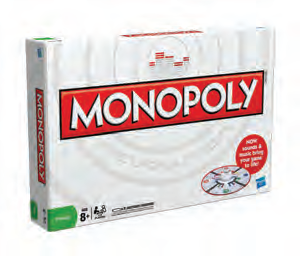 staid old board with sound effects and credit cards instead of cash. Buying houses you can’t afford in real life is fun! History’s happiest accident—the Slinky— has
staid old board with sound effects and credit cards instead of cash. Buying houses you can’t afford in real life is fun! History’s happiest accident—the Slinky— has
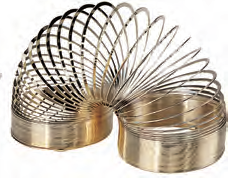 returned to the family staircase in a 14- karat, gold-plated-brass 55th Anniversary Edition ($100 at Buy.com). According to legend, the discovery that the spring could “walk” was completely serendipitous. The rest is history, with more than 300 million sold and still counting. Another beloved blast from the past is the Rubiks Cube, now available in a glitzy high-tech Rubiks
returned to the family staircase in a 14- karat, gold-plated-brass 55th Anniversary Edition ($100 at Buy.com). According to legend, the discovery that the spring could “walk” was completely serendipitous. The rest is history, with more than 300 million sold and still counting. Another beloved blast from the past is the Rubiks Cube, now available in a glitzy high-tech Rubiks TouchCube version (on amazon.com for about $70). Nostalgia is also available in book form. The Official Preppy Handbook, that iconic, tongue-in-cheek treatise on the WASP-y culture of the 1980s, finally has its longa waited sequel. One of the original authors has taken another satirical look at the “new old guard” in True Prep: It’s a Whole New World.
TouchCube version (on amazon.com for about $70). Nostalgia is also available in book form. The Official Preppy Handbook, that iconic, tongue-in-cheek treatise on the WASP-y culture of the 1980s, finally has its longa waited sequel. One of the original authors has taken another satirical look at the “new old guard” in True Prep: It’s a Whole New World. 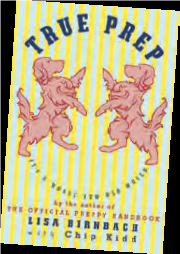 Buy it in hardcover at your local brick-and-mortar bookseller, or go for the preppier Kindle or iPad editions.
Buy it in hardcover at your local brick-and-mortar bookseller, or go for the preppier Kindle or iPad editions.
CHRISTMAS PRESENT An unfortunate reality of being a self-indulgent grown-up is that fitness and  exercise equipment often migrates onto our holiday wish lists. If you think walking (or even running) is for wimps—and can put off that new car purchase for another year—then you might want to trade in your treadmill for a Treadwall, a motorless rotating climbing wall that moves by body weight alone. The good news is you are never more than 1-2 feet off the floor. The bad news is that this will set you back about $10,000 (a KidWall version is less). Check it out at uniquefit1.com or call around to some climber-friendly gyms. If work intrudes on your workout, then consider equipping your home office with a Gaiam BalanceBall Chair (on Amazon.com for about $80).
exercise equipment often migrates onto our holiday wish lists. If you think walking (or even running) is for wimps—and can put off that new car purchase for another year—then you might want to trade in your treadmill for a Treadwall, a motorless rotating climbing wall that moves by body weight alone. The good news is you are never more than 1-2 feet off the floor. The bad news is that this will set you back about $10,000 (a KidWall version is less). Check it out at uniquefit1.com or call around to some climber-friendly gyms. If work intrudes on your workout, then consider equipping your home office with a Gaiam BalanceBall Chair (on Amazon.com for about $80).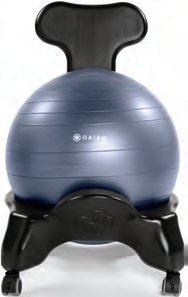 Chiropractically engineered, the chair continues working those core muscles even if you sit at your desk for hours. You’re basically buying the chair’s framework; the rest is BYOB (Bring Your Own Ball). It’s the same balance ball you use in your workout routines. Need to exercise on the road? You’ll have no more excuses away from home thanks to the Tumi Travel Fitness Trainer. It’s equipped with a pedometer, heart rate monitor, stopwatch, MP3 player and FM radio. Look for it at the Tumi store in the Short Hills Mall (or online at tumi.com) for about $165. Masochism comes in myriad forms, not all of which involve calorie burning workouts. Golf leaps to mind. Feeling the
Chiropractically engineered, the chair continues working those core muscles even if you sit at your desk for hours. You’re basically buying the chair’s framework; the rest is BYOB (Bring Your Own Ball). It’s the same balance ball you use in your workout routines. Need to exercise on the road? You’ll have no more excuses away from home thanks to the Tumi Travel Fitness Trainer. It’s equipped with a pedometer, heart rate monitor, stopwatch, MP3 player and FM radio. Look for it at the Tumi store in the Short Hills Mall (or online at tumi.com) for about $165. Masochism comes in myriad forms, not all of which involve calorie burning workouts. Golf leaps to mind. Feeling the  burn in this sport mostly happens between the ears. If greens are what get you blue, then consider the Laser Alignment Putting Trainer, which uses a laser beam to tell you when your putt is perfect— before you even touch the ball. Look for it online at hammacher.com for $329.95.
burn in this sport mostly happens between the ears. If greens are what get you blue, then consider the Laser Alignment Putting Trainer, which uses a laser beam to tell you when your putt is perfect— before you even touch the ball. Look for it online at hammacher.com for $329.95.
CHRISTMAS FUTURE If racing ahead of the pack gets you in the holiday spirit, then  you’ll be happy to hear that the toys of tomorrow are here today. For instance, you can actually carry around a computer in a pen with the LiveScribe Echo Smartpen. It captures everything you hear, write or say and delivers it with just a tap of the pen ($170 for 4GB and $200 for
you’ll be happy to hear that the toys of tomorrow are here today. For instance, you can actually carry around a computer in a pen with the LiveScribe Echo Smartpen. It captures everything you hear, write or say and delivers it with just a tap of the pen ($170 for 4GB and $200 for  8 GB versions at livescribe.com; also at Target). Or treat yourself to a Gyration Air Mouse, which controls apps on your computer, TV or DVD player with a wave of your hand ($70 and up at amazon.com or compusa.com). Gadget gals are turning cartwheels over the latest Flip Video Cams.
8 GB versions at livescribe.com; also at Target). Or treat yourself to a Gyration Air Mouse, which controls apps on your computer, TV or DVD player with a wave of your hand ($70 and up at amazon.com or compusa.com). Gadget gals are turning cartwheels over the latest Flip Video Cams.
 Their fetching case artwork belies their impressive HD video capabilities, with up to two hours of record time ($150 to $230). Best to go direct to theflip.com, where you can even upload your own photo for a personalized one-of-a-kind camera. If your final wish for 2010 (or final wish, period) is to careen down a snow-covered slope at 70 mph, then you’ll want to invest in an Airboard. Think of these Swiss-engineered inflatables as really Felixible Flyers. Popular for years in Europe, the Airboard has just begun appearing on American mountainsides. You may want to rent before you buy (they sell for $200 to $630 at airboard.com), and probably review your insurance policy. If your thrill-seeking tends to be a bit less public, then the Spy Net Secret Mission Video Watch may be more your speed. It’s a 21st Century take on those old decoder rings buried at the bottom of cereal boxes. It can audio record for 3 hours, video record for 20 minutes, and take still photos with a snake cam that lets you see around corners ($50 at jakks.com and also carried by Kmart).
Their fetching case artwork belies their impressive HD video capabilities, with up to two hours of record time ($150 to $230). Best to go direct to theflip.com, where you can even upload your own photo for a personalized one-of-a-kind camera. If your final wish for 2010 (or final wish, period) is to careen down a snow-covered slope at 70 mph, then you’ll want to invest in an Airboard. Think of these Swiss-engineered inflatables as really Felixible Flyers. Popular for years in Europe, the Airboard has just begun appearing on American mountainsides. You may want to rent before you buy (they sell for $200 to $630 at airboard.com), and probably review your insurance policy. If your thrill-seeking tends to be a bit less public, then the Spy Net Secret Mission Video Watch may be more your speed. It’s a 21st Century take on those old decoder rings buried at the bottom of cereal boxes. It can audio record for 3 hours, video record for 20 minutes, and take still photos with a snake cam that lets you see around corners ($50 at jakks.com and also carried by Kmart).

Editor’s Note: Chris Gibbs is the brains behind EDGE’s “It’s A Gift” section. She’s been waiting all year to do this story!
In Search of the Ultimate Sports Poster
 Most experts agree that there are four cornerstones to a successful marriage. 1. Trust. 2. Honesty. 3. Unexpressed anger. 4. No sports junk on the walls. Many a man has tested rule #4 only to see that framed jersey or signed photo, without warning, donated to a local charity auction. Like a game of Jumanji, the priceless
Most experts agree that there are four cornerstones to a successful marriage. 1. Trust. 2. Honesty. 3. Unexpressed anger. 4. No sports junk on the walls. Many a man has tested rule #4 only to see that framed jersey or signed photo, without warning, donated to a local charity auction. Like a game of Jumanji, the priceless  heirloom insidiously then works its way into another home, where it initiates marital chaos all over again. Bill Crouse is the exception that proves rule #4. One of the world’s leading authorities on Art Deco posters, his collection may be the best ever assembled. When Crouse purchases a sports poster, it’s invariably a jaw-dropper. In these pages we present a handful of sporting selections from the renowned Crouse Collection. You won’t find these masterpieces at your suburban gala or fundraiser. You will see them in museums and galleries in Europe and the U.S. (including right now at the Guggenheim’s Chaos and Classicism exhibit). If you want to buy them at auction, be prepared to spend somewhere in the mid-six figures!
heirloom insidiously then works its way into another home, where it initiates marital chaos all over again. Bill Crouse is the exception that proves rule #4. One of the world’s leading authorities on Art Deco posters, his collection may be the best ever assembled. When Crouse purchases a sports poster, it’s invariably a jaw-dropper. In these pages we present a handful of sporting selections from the renowned Crouse Collection. You won’t find these masterpieces at your suburban gala or fundraiser. You will see them in museums and galleries in Europe and the U.S. (including right now at the Guggenheim’s Chaos and Classicism exhibit). If you want to buy them at auction, be prepared to spend somewhere in the mid-six figures!
Cycles Brillant • A. M. Cassandre (1901-1968) Only a few copies of this 1925 poster—a gleaming example of Cassandre’s adherence to minimalism—are know to exist. Not many commercial artists would be brave enough to hand a client an ad concept for a bicycle that shows no details of the product. Even fewer could actually pull it off.
Campeonato Abierto de Basket-Ball • Caroselli (Dates Unknown) The image of the angled competitor was popular among  Art Deco posterists. In this advertisement for a 1934 tournament, Caroselli used this technique—along with an airbrushed black “cocoon”—to capture the energy of a layup.
Art Deco posterists. In this advertisement for a 1934 tournament, Caroselli used this technique—along with an airbrushed black “cocoon”—to capture the energy of a layup.
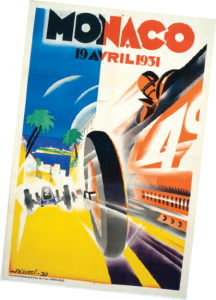 Monaco/19 Avril 1931 • Robert Falcucci (1900-1989) This rarest of Monaco GP posters—possibly the only example in private hands—shows a Mercedes SSK in hot pursuit of a red Bugatti. Falcucci’s use of white streaks running the length of the racer, concentric arcs of white behind to convey the rush of the wind, and the bright palette of red, yellow and blue give this streamlined design great panache. A multitalented painter, decorator and illustrator, Falcucci received his formal training in Paris and served as the historical painter for the French Army.
Monaco/19 Avril 1931 • Robert Falcucci (1900-1989) This rarest of Monaco GP posters—possibly the only example in private hands—shows a Mercedes SSK in hot pursuit of a red Bugatti. Falcucci’s use of white streaks running the length of the racer, concentric arcs of white behind to convey the rush of the wind, and the bright palette of red, yellow and blue give this streamlined design great panache. A multitalented painter, decorator and illustrator, Falcucci received his formal training in Paris and served as the historical painter for the French Army.
Beristain/Todo Para Deportes • Jacint Bofarull (1903-?) on prior page Although Bofarull earned a reputation as a politically outspoken artist, none of his political leanings are evident in this promotion for Beristain’s Barcelona department store and its line of sporting equipment and apparel. Despite the fact that pipe-smoking is no longer a part of sports, it would not be a stretch to call this 80-year-old poster “timeless.”
Coupe Davis • A. M. Cassandre (1901-1968) In Cassandre’s advertisement for the 1932 Davis Cup, he grabs viewers’ 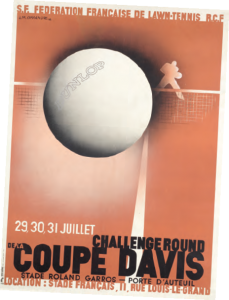
 attention by placing them in the path of an oncoming shot at net. The use of geometry and dynamic perspective in this extraordinarily rare poster— as well as the ease with which the design’s elements are assembled—are superb examples of what made Cassandre the most important Art Deco figure in the history of advertising posters.
attention by placing them in the path of an oncoming shot at net. The use of geometry and dynamic perspective in this extraordinarily rare poster— as well as the ease with which the design’s elements are assembled—are superb examples of what made Cassandre the most important Art Deco figure in the history of advertising posters.
Mistrzostwo Swiata/Krynica 1931 • Stefan Osiecki (1902-1939) Jerzy Skolimowski (1907-1985) This promotion for the 1931 World Ice Hockey Championships in Poland can barely contain the action within the frame. The featureless depiction of the competitors captures the team-oriented nature of the sport, while the flags along the bottom clearly convey that 10 national teams will by vying for the title.
Sables d’Or les Pins • Lec (Dates Unknown) For the dedicated golfer, playing a well-designed course borders on a religious experience. In this breathtaking 1926 poster, the artist captures this feel using a stained-glass style.
 III Olympic Winter Games • Witold Gordon (1885-1968) Gordon left no doubt in this iconic poster where the center of the
III Olympic Winter Games • Witold Gordon (1885-1968) Gordon left no doubt in this iconic poster where the center of the 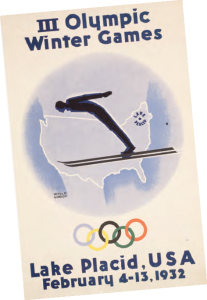 sports universe would be in February of 1932: Lake Placid. These Winter Games—the first held in North America—were opened by New York Governor (and soon-to-be U.S. President) Franklin Roosevelt. Gordon also designed the grand murals at Radio City Music Hall and the 1939 World’s Fair.”
sports universe would be in February of 1932: Lake Placid. These Winter Games—the first held in North America—were opened by New York Governor (and soon-to-be U.S. President) Franklin Roosevelt. Gordon also designed the grand murals at Radio City Music Hall and the 1939 World’s Fair.”
World’s Greatest Air Race • Percy Trompf (1902-1964) The 1934 England-to- Australia air race covered more than 11,000 miles and was won by Lieutenant Charles William Anderson Scott and Captain Tom Campbell Black. Their scarlet DH.88 Comet finished with a time of 71 hours. Art Deco posters typically pared down or simplified the human element. However, in this poster, Trompf chose to zero in on the pilot’s face to convey the focus, determination and uncompromising will of the participants. Trompf created thousands of posters for companies in his native Australia, and attracted clients in England and Canada, too.
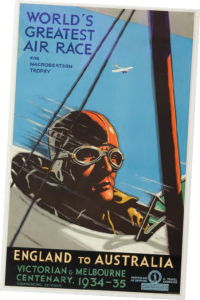 1er Campeonato Mondial de Football • Guillermo Laborde (1886-1940) This poster for the inaugural World Cup is the Holy Grail collectible for soccer fans. Laborde conveys the action and athleticism of the sport with
1er Campeonato Mondial de Football • Guillermo Laborde (1886-1940) This poster for the inaugural World Cup is the Holy Grail collectible for soccer fans. Laborde conveys the action and athleticism of the sport with  just a few linear elements. An acclaimed South American artist and sculptor, he agreed to judge the poster submissions for the 1930 World Cup. Later, Laborde resigned from the panel and submitted two of his own—which came in first and third.
just a few linear elements. An acclaimed South American artist and sculptor, he agreed to judge the poster submissions for the 1930 World Cup. Later, Laborde resigned from the panel and submitted two of his own—which came in first and third.
Editor’s Note: Special thanks to Tim Gazinski for his assistance in selecting and describing these posters. William Crouse’s 2009 book Grand Prix Automobile de Monaco Posters was hailed as “unmatched in the field” by the International Poster Center.
built on sand doth crumble, but the palace built on silk endures.’
—14th Century Chinese Proverb
 Silk, the fabric of kings and emperors—of nobility, popes and czars—has always signified wealth, prestige and luxury. Always? Probably, that is if you agree that a commodity cherished since 5000 B.C. merits such a term of longevity. Pharaohs dating back at least that far have been disentombed, their royal cadavers worshipfully swathed in silk. In ancient Rome, the wearing of silk was forbidden the ordinary citizen. Only members of the imperial family could appear in public wearing it. In Europe, by the 15th century, the French city of Lyon was calling itself the Silk Capital of the World.
Silk, the fabric of kings and emperors—of nobility, popes and czars—has always signified wealth, prestige and luxury. Always? Probably, that is if you agree that a commodity cherished since 5000 B.C. merits such a term of longevity. Pharaohs dating back at least that far have been disentombed, their royal cadavers worshipfully swathed in silk. In ancient Rome, the wearing of silk was forbidden the ordinary citizen. Only members of the imperial family could appear in public wearing it. In Europe, by the 15th century, the French city of Lyon was calling itself the Silk Capital of the World. How justified was that claim? Well, when that bit of braggadocio first surfaced, it’s more than possible that China, Korea, India and who knows what other kingdoms might well have challenged Lyon for the title. But today, in the rarefied world of haute couture, Lyon with its silken boast, is right on the money. A city of half a million, Lyon is situated between two rivers: the fast-flowing Rhone and the gently flowing Soane, both passing the city, southbound to the Mediterranean. Of its long and proud history, suffice it to say that it once was the capital of Gaul and often visited by more than one Emperor. In the last two or three years, the traboules of Lyon, those 18th-century covered passageways that crisscross the silk workers’ district, have seen a virtual stampede of designers and couturiers. They fly in from Milan, New York, Tokyo and all points in between. Their names read like a celestial roll call in the paradise of high fashion. Dior, Lanvin, Chanel, Versace, Vera Wang. They come intent on securing exclusivity, or the nearest thing thereto, on the exquisite fabrics that spill forth from the looms of Lyon. Silk, which never ever was out, is now more than ever in. From the silk-wrapped heels of shoes by Dries van Noten to the extravagant ruffles of Lanvin’s evening wear, the word is SILK. Contradicting everything that fashion pundits know about trend, style and fad, silk retains its hold on elegance even while it also successfully teams up with jeans, beach wear and the most casual of the casual. Not possible! Yet true. Lyon owes much of its silky prestige to François I, the first Renaissance king to grace the French throne. A major patron of the arts and a great admirer of Italian style and elegance, he was determined to see France surpass Italy in all artistic endeavors. To that end he persuaded the great Leonardo da Vinci to quit his native Tuscany and come to live in France. Leonardo packed up bag and baggage, tucking into his luggage his favorite opus, “La Gioconda” (aka Mona Lisa). After he died in 1519, cradled in the arms of a weeping King François, that masterpiece became French property. Today it hangs in the Louvre in Paris where, as a touristic attraction, it ranks second only to the Eiffel Tower. Apart from luring Leonardo and his Mona Lisa to France, Francois I also determined that the weavers of Lyon, specialists i
How justified was that claim? Well, when that bit of braggadocio first surfaced, it’s more than possible that China, Korea, India and who knows what other kingdoms might well have challenged Lyon for the title. But today, in the rarefied world of haute couture, Lyon with its silken boast, is right on the money. A city of half a million, Lyon is situated between two rivers: the fast-flowing Rhone and the gently flowing Soane, both passing the city, southbound to the Mediterranean. Of its long and proud history, suffice it to say that it once was the capital of Gaul and often visited by more than one Emperor. In the last two or three years, the traboules of Lyon, those 18th-century covered passageways that crisscross the silk workers’ district, have seen a virtual stampede of designers and couturiers. They fly in from Milan, New York, Tokyo and all points in between. Their names read like a celestial roll call in the paradise of high fashion. Dior, Lanvin, Chanel, Versace, Vera Wang. They come intent on securing exclusivity, or the nearest thing thereto, on the exquisite fabrics that spill forth from the looms of Lyon. Silk, which never ever was out, is now more than ever in. From the silk-wrapped heels of shoes by Dries van Noten to the extravagant ruffles of Lanvin’s evening wear, the word is SILK. Contradicting everything that fashion pundits know about trend, style and fad, silk retains its hold on elegance even while it also successfully teams up with jeans, beach wear and the most casual of the casual. Not possible! Yet true. Lyon owes much of its silky prestige to François I, the first Renaissance king to grace the French throne. A major patron of the arts and a great admirer of Italian style and elegance, he was determined to see France surpass Italy in all artistic endeavors. To that end he persuaded the great Leonardo da Vinci to quit his native Tuscany and come to live in France. Leonardo packed up bag and baggage, tucking into his luggage his favorite opus, “La Gioconda” (aka Mona Lisa). After he died in 1519, cradled in the arms of a weeping King François, that masterpiece became French property. Today it hangs in the Louvre in Paris where, as a touristic attraction, it ranks second only to the Eiffel Tower. Apart from luring Leonardo and his Mona Lisa to France, Francois I also determined that the weavers of Lyon, specialists i n the secrets of silk-making, should be elevated to the front ranks of French commerce. To accomplish his objective he opened the royal purse strings to attract Europe’s finest weavers. Before his reign ended in 1547, Lyon was acknowledged as the primary source for the finest silks the world had ever seen. For the next 300 years, the weavers of Lyon thrived, lodged in high-ceilinged buildings, designed to accommodate their huge hand-operated looms. Today the looms of Lyon are high-tech marvels, controlled by computers. But in the section known as Croix Rouge, a handful of the ancient looms remain. To the delight of tourists, the weavers perform their ancient rites, still turning out priceless yardage. Few who watch the process escape a visit to the adjoining gift shops, all amply stocked with scarves, shawls, ties, skirts, shirts, purses, bedding, all of course of priceless silk. “I use silk in every one of my collections,” says Andrew Gn, the Singapore-born, Paris-based designer whose highfashion creations are carried by Bergdorf Goodman. “Silk drapes much better than anything else…and the contact of silk with skin is irreplaceable.” In his forthcoming Spring/Summer 2011 collection, Gn uses a magnificent triple-silk crepe, specially woven for his atelier. As he puts it, “Silk translates colors much better; it makes them extremely rich.” His clientele consists in large part of individuals seeking one of- a-kind creations which can be worn in the sure knowledge that her choice will not be replicated. (It’s an assurance that doesn’t come at bargain prices!) Monsieur Gn’s clientele, which includes a healthy smattering of royalty and easily-recognized names from the world of diplomats and heads of state, professes fierce loyalty to their designer of choice. Simply put, “He’s a genius,” was the gratuitous observation by an obviously satisfied client. For Andre Claude Canova, a passion for the silks of Lyon began more than a quarter of a century ago. Today he designs his own collection, which includes the most exquisite silk scarves—some of which encompass as many as 15 or 20 different colors, an achievement unequalled by any other designer. His studio at 26 Quai St.Vincent in the heart of Lyon is an old Carthusian residence, its entrance a handsome horseshoe-shaped Renaissance staircase. Favored buyers are received in its superbly furnished salons, the walls lined with…what else? Pure silk. The ambience is unmistakably Old World but the scarves, vests, pillows and jackets are on the very cutting edge. His own special design of scarf suspenders created a minor tsunami in the world of fashion when they first appeared. Supermodel Jerry Hall was so enchanted with them that she ordered 20 pairs. Princess Caroline of Monaco is frequently photographed in them and when the G-7 convened in Lyon, Bill and Hillary were delighted to be presented with a selection of Canova scarf-suspenders. An undoubted original, Andre Claude-Canova, when asked the source of his creative inspirations, replied, “Travel, history, nature.” He went on, “It can be a sunset in Tuscany, the masks of the Maasai, the silky pearl shades of a Maharajah’s robes, or the jewels of the Taj Mahal…” But the one constant in all of his creations is silk, woven in an unmatched panoply of colors. The distinction of being the oldest silk factory in Lyon belongs to Prelle et Cie, which has been in continuous operation since 1752 and is owned today by direct descendents of its founders. Apart from its stylish contemporary output of scarves, ties, shawls and other pieces, Prelle has proven invaluable in the rarefied world of authentic restoration of palaces and castles, historical houses and public places. It counts among its restorative masterpieces the authentic recreation of the silk brocades used in the Royal Bedchamber of the Sun King, Louis XIV, at Versailles, the draperies and upholstered pieces at Biltmore in North Carolina and at Ash Lawn, the ancestral home in Virginia of James Monroe. Such historical replication of two- and three-hundred-yearold fabrics is possible thanks in part to the exquisite workmanship of the Prelle artisans, and in part to the company’s scrupulously maintained archives, which date back four centuries.
n the secrets of silk-making, should be elevated to the front ranks of French commerce. To accomplish his objective he opened the royal purse strings to attract Europe’s finest weavers. Before his reign ended in 1547, Lyon was acknowledged as the primary source for the finest silks the world had ever seen. For the next 300 years, the weavers of Lyon thrived, lodged in high-ceilinged buildings, designed to accommodate their huge hand-operated looms. Today the looms of Lyon are high-tech marvels, controlled by computers. But in the section known as Croix Rouge, a handful of the ancient looms remain. To the delight of tourists, the weavers perform their ancient rites, still turning out priceless yardage. Few who watch the process escape a visit to the adjoining gift shops, all amply stocked with scarves, shawls, ties, skirts, shirts, purses, bedding, all of course of priceless silk. “I use silk in every one of my collections,” says Andrew Gn, the Singapore-born, Paris-based designer whose highfashion creations are carried by Bergdorf Goodman. “Silk drapes much better than anything else…and the contact of silk with skin is irreplaceable.” In his forthcoming Spring/Summer 2011 collection, Gn uses a magnificent triple-silk crepe, specially woven for his atelier. As he puts it, “Silk translates colors much better; it makes them extremely rich.” His clientele consists in large part of individuals seeking one of- a-kind creations which can be worn in the sure knowledge that her choice will not be replicated. (It’s an assurance that doesn’t come at bargain prices!) Monsieur Gn’s clientele, which includes a healthy smattering of royalty and easily-recognized names from the world of diplomats and heads of state, professes fierce loyalty to their designer of choice. Simply put, “He’s a genius,” was the gratuitous observation by an obviously satisfied client. For Andre Claude Canova, a passion for the silks of Lyon began more than a quarter of a century ago. Today he designs his own collection, which includes the most exquisite silk scarves—some of which encompass as many as 15 or 20 different colors, an achievement unequalled by any other designer. His studio at 26 Quai St.Vincent in the heart of Lyon is an old Carthusian residence, its entrance a handsome horseshoe-shaped Renaissance staircase. Favored buyers are received in its superbly furnished salons, the walls lined with…what else? Pure silk. The ambience is unmistakably Old World but the scarves, vests, pillows and jackets are on the very cutting edge. His own special design of scarf suspenders created a minor tsunami in the world of fashion when they first appeared. Supermodel Jerry Hall was so enchanted with them that she ordered 20 pairs. Princess Caroline of Monaco is frequently photographed in them and when the G-7 convened in Lyon, Bill and Hillary were delighted to be presented with a selection of Canova scarf-suspenders. An undoubted original, Andre Claude-Canova, when asked the source of his creative inspirations, replied, “Travel, history, nature.” He went on, “It can be a sunset in Tuscany, the masks of the Maasai, the silky pearl shades of a Maharajah’s robes, or the jewels of the Taj Mahal…” But the one constant in all of his creations is silk, woven in an unmatched panoply of colors. The distinction of being the oldest silk factory in Lyon belongs to Prelle et Cie, which has been in continuous operation since 1752 and is owned today by direct descendents of its founders. Apart from its stylish contemporary output of scarves, ties, shawls and other pieces, Prelle has proven invaluable in the rarefied world of authentic restoration of palaces and castles, historical houses and public places. It counts among its restorative masterpieces the authentic recreation of the silk brocades used in the Royal Bedchamber of the Sun King, Louis XIV, at Versailles, the draperies and upholstered pieces at Biltmore in North Carolina and at Ash Lawn, the ancestral home in Virginia of James Monroe. Such historical replication of two- and three-hundred-yearold fabrics is possible thanks in part to the exquisite workmanship of the Prelle artisans, and in part to the company’s scrupulously maintained archives, which date back four centuries.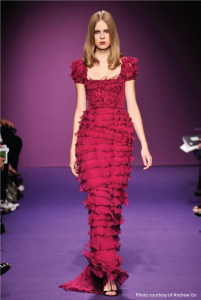 Patterns, hand-drawn in quill and ink, with color samples provided in watercolor paints—their intricate designs sketched in painstaking detail and selected for use in palaces, stately homes, public halls—were recorded and filed. Thus modern-day restorers are able to see exactly what designs and what colors were used in specific venues centuries past. No other silk weaving establishment anywhere in the world can claim as much. In addition to its French premises, Prelle also maintains a showroom in New York at 43 E. 10th Street. Apart from its gilded salons and showrooms frequented by the world’s top designers, Lyon has more than its fair share of stylish boutiques. All along the Rue de la Republique (incidentally, the longest pedestrian street in France), the very latest trends are fetchingly displayed in shop windows. Come early December, Lyon celebrates the Festival of Lights. For one glorious week the town is lighted throughout the night. Music seems to pour from every doorway; mimes, jugglers and troupes of musicians are everywhere. It’s as if the whole city was tripping out on some incredible potion. The restaurants—1,000 of them at last count—do a landslide business, for gastronomy in Lyon is a source of huge civic pride. It’s not for nothing that Lyon is often called the “best-fed” city in France. When I repeated the epitaph to a Lyonnais, he quickly put me straight: “The best-fed city not in France, but in Europe!” So much for local modesty. Then again, it’s no mere coincidence that Paul Bocuse, the high priest of French gastronomy, chooses to live in Lyon, where he presides over two restaurants. A world famous chef who actually cooks? It sounds ordinary enough, but in the tippy-top layers of prize-winning, globally-acclaimed chefs, it’s rare enough to elicit expressions of wonder from fellow chefs. A final word of advice. Don’t journey to the city in search of bargains. It’s doubtful that Lyon even knows the meaning of the word. But if it’s quality you seek, if it’s the full value of every Euro spent, then quite definitely, Lyon may be just the city for you.
Patterns, hand-drawn in quill and ink, with color samples provided in watercolor paints—their intricate designs sketched in painstaking detail and selected for use in palaces, stately homes, public halls—were recorded and filed. Thus modern-day restorers are able to see exactly what designs and what colors were used in specific venues centuries past. No other silk weaving establishment anywhere in the world can claim as much. In addition to its French premises, Prelle also maintains a showroom in New York at 43 E. 10th Street. Apart from its gilded salons and showrooms frequented by the world’s top designers, Lyon has more than its fair share of stylish boutiques. All along the Rue de la Republique (incidentally, the longest pedestrian street in France), the very latest trends are fetchingly displayed in shop windows. Come early December, Lyon celebrates the Festival of Lights. For one glorious week the town is lighted throughout the night. Music seems to pour from every doorway; mimes, jugglers and troupes of musicians are everywhere. It’s as if the whole city was tripping out on some incredible potion. The restaurants—1,000 of them at last count—do a landslide business, for gastronomy in Lyon is a source of huge civic pride. It’s not for nothing that Lyon is often called the “best-fed” city in France. When I repeated the epitaph to a Lyonnais, he quickly put me straight: “The best-fed city not in France, but in Europe!” So much for local modesty. Then again, it’s no mere coincidence that Paul Bocuse, the high priest of French gastronomy, chooses to live in Lyon, where he presides over two restaurants. A world famous chef who actually cooks? It sounds ordinary enough, but in the tippy-top layers of prize-winning, globally-acclaimed chefs, it’s rare enough to elicit expressions of wonder from fellow chefs. A final word of advice. Don’t journey to the city in search of bargains. It’s doubtful that Lyon even knows the meaning of the word. But if it’s quality you seek, if it’s the full value of every Euro spent, then quite definitely, Lyon may be just the city for you.
EDGE Editor’s Note: Special thanks to Erick Horlin
Why resolutions fail (and how yours can succeed).
 If you’re planning to make 2011 the year you lose weight and get fit, join the club: Studies show these are the most common resolutions people make come January 1st. Good luck to you; the grim reality is that most of the people who start the year off wanting to slim down don’t end up succeeding. The same goes for other popular New Year’s vows—stop smoking, get out of debt, help others, etc., etc. etc. The bottom line is that we just aren’t wired to break habits overnight that we’ve developed over 10, 20 or 30 years. As individuals, human beings tend to value their individuality. As a species, we’re just plain stubborn. Some great minds have weighed in on this subject. The controversial author Anaïs Nin insisted she made no resolutions to curb her habits, because “the habit of making plans, of criticizing, sanctioning and molding my life, is too much of a daily event for me.” Sculptor Henry Moore preferred to “think in terms of the day’s resolutions, not the year’s.” Writer Oscar Wilde, whose list of questionable habits was practically endless, characterized resolutions as “checks that men draw on a bank where they have no account.” Comic Joey Adams’s favorite party toast was “May all your troubles last as long as your New Year’s resolutions.” Mark Twain evaluated New Year’s resolutions with a single word: Humbug. Given this overwhelming preponderance of intellectual evidence, what chance do we mere mortals have to drop a few pounds and elevate our fitness? According to Michelle Ali, a registered dietician at Trinitas Regional Medical Center, there are 10 things we can do to improve the odds:
If you’re planning to make 2011 the year you lose weight and get fit, join the club: Studies show these are the most common resolutions people make come January 1st. Good luck to you; the grim reality is that most of the people who start the year off wanting to slim down don’t end up succeeding. The same goes for other popular New Year’s vows—stop smoking, get out of debt, help others, etc., etc. etc. The bottom line is that we just aren’t wired to break habits overnight that we’ve developed over 10, 20 or 30 years. As individuals, human beings tend to value their individuality. As a species, we’re just plain stubborn. Some great minds have weighed in on this subject. The controversial author Anaïs Nin insisted she made no resolutions to curb her habits, because “the habit of making plans, of criticizing, sanctioning and molding my life, is too much of a daily event for me.” Sculptor Henry Moore preferred to “think in terms of the day’s resolutions, not the year’s.” Writer Oscar Wilde, whose list of questionable habits was practically endless, characterized resolutions as “checks that men draw on a bank where they have no account.” Comic Joey Adams’s favorite party toast was “May all your troubles last as long as your New Year’s resolutions.” Mark Twain evaluated New Year’s resolutions with a single word: Humbug. Given this overwhelming preponderance of intellectual evidence, what chance do we mere mortals have to drop a few pounds and elevate our fitness? According to Michelle Ali, a registered dietician at Trinitas Regional Medical Center, there are 10 things we can do to improve the odds: 
1 Don’t Go Overboard There’s a real temptation to sprint out of the gate and make drastic changes to your diet and workout routines. But being gung-ho from the get-go can lead to burnout and failure down the line. “Unrealistic goals hurt us more than we realize,” says Ali. “Weight loss should be slow, about a pound a week.” She advises skipping a full-scale renovation in favor of making slow and subtle changes that can become a permanent part of your life. “Make one food change each month and stick to it. That’ll make weight loss happen—and make it permanent.”
2 Monitor Portion Size Those supersized portions of food you often see at restaurants are rarely the right amount of food to keep you at a healthy size. “Far too often we are unaware of what a serving of a particular food is,” Ali says. “For example, for protein foods such as chicken or beef, a serving is considered to be 3 ounces, or the size of a deck of cards. Most Americans consumes more than twice the amount of protein that is needed by their bodies.”
3 Don’t Skip Meals It may seem like a smart idea to avoid eating those extra calories, but studies show that this method can backfire, especially if it’s breakfast that you skip. “Breakfast really sets the mood for the rest of the day,” Ali says. “Skipping breakfast slows down your metabolism and causes you to overeat at other times.”
4 Create a Food Diary Keep track of what you’re eating and when. Studies have shown that writing down your daily diet can help you consume fewer calories and be more thoughtful about the choices you make. If you don’t want to use a pad of paper, consider signing up for an online weight-loss tool like SparkPeople.com, where you can record your daily diet and track calories, protein, fat and more.
5 Be Salad Savvy You may feel very virtuous with that plate of greens in front of you, but the dreamy dressing you choose could turn that salad into a caloric nightmare. “One frequent mistake that people make is that they load up on salads and use far too much salad dressing,” Ali says. “Regular salad dressings are loaded with calories, which comes mainly from fat and, when use in abundance, defeat the purpose.” Stick with vinaigrettes in lieu of the creamier mayonnaise-based dressings, or make a simple (and delicious) one at home with olive oil, lemon juice and vinegar.
6 Read the Label You might be surprised to find that that can of soup or container of ice cream that claims to be healthier for you actually comes with a pretty hefty calorie count. “You will be surprised at what you’ll find when you compare one product to another—especially when we compare things like fat, sugar and sodium,” Ali says. “Be sure to look at some dietetic foods that may claim to be low in sugar and or fat—you may find that the regular product is lower in total calories.”
7 Avoid Fad Diets There’s always a new trendy diet to try—high-protein, low-carb, no-fat, the infamous cabbage soup diet—but even if you start off your fad diet peeling off the pounds, odds are the effects won’t last. “Crash diets never lead to permanent weight loss,” Ali says. “To succeed, you must commit to a healthy lifestyle for a lifetime.”
8 Exercise Cutting back on your food intake is only one piece of the puzzle. For consistent weight loss success, you’re going to have to work up a sweat. “When we lose weight we lose both fat and muscle, but exercise can preserve lean body mass,” Ali says. “Exercise speeds up our metabolism and helps us to burn more calories—and toned muscles also make us look better in our clothes.”
9 Make It Fun “If jogging’s not your thing, find an activity you enjoy doing,” Ali says. That way, exercise doesn’t become a chore—it’s an enjoyable part of your day.
10 Don’t Give Up Even if you had a bad day (and a Snickers bar or two), it isn’t the end of the world—or even the end of your diet. Remember that tomorrow is another day. Vow to do better. EDGE
In the television and publishing industries, you often hear the expression, “It’s a numbers game.” Perhaps that explains how DANICA McKELLAR found success in both. As Winnie Cooper on The Wonder Years, she captured the hearts and minds of a generation of viewers, and had one of the most-recognized faces in America. More recently, McKellar has connected with an entirely new generation of young people—this time as an author whose captivating and empowering books on math have made the New York Times Best Seller List. In 2010, McKellar turned her attention toward multiplication, as she welcomed her first child into the world. EDGE Assignments Editor Zack Burgess caught Danica at home in California between books and, it turns out, between feedings.
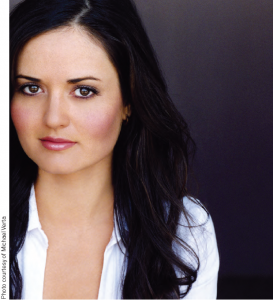
EDGE: You are a new mom, a working actress and a best-selling author. Are your math skills finally being tested when it comes to dividing your time?
DM: (Laughing) I’m not sure if the skill that’s being tested now has ever been in a category of my life before: Sleep Deprivation. There’s not a lot of math that has come into being a mother yet, but I’m sure that there will be. One other thing, I’m breastfeeding— so there is no formula, no bottles, no calculation of how many ounces and how often. There’s just breastfeeding on demand, the most non-mathematical way to go.
EDGE: There are a lot of interesting ways to go with the math degree you earned at UCLA. What were some of the options you considered?
DM: I actually considered very strongly becoming a professor of mathematics. But I missed acting. I missed entertainment. So for me to be able to write entertaining math books, to combine the two things that I love, is perfect.
EDGE: How did the math books come about?
DM: After I graduated, I went back to acting. I was on The West Wing and doing some other things. Because I missed math and didn’t want to abandon it, I  started a math advice column in which I answered people’s math questions. After I finished The West Wing, there was an article about me in the Science section of The New York Times. From that article came an offer to write a math book. I realized that I had been preparing to write this book for a long time without knowing it—first, by being a math major and, second, by writing the column.
started a math advice column in which I answered people’s math questions. After I finished The West Wing, there was an article about me in the Science section of The New York Times. From that article came an offer to write a math book. I realized that I had been preparing to write this book for a long time without knowing it—first, by being a math major and, second, by writing the column.
EDGE: Your first book, Math Doesn’t Suck, was written with teenage girls in mind. You actually spoke before Congress about the importance of women in mathematics.
DM: Yes, and that’s when I knew the kind of math book I wanted to write. The middle school years are the most crucial for girls and math. It’s a time when they decide they’re not good at math because of social pressures and stereotypes. It’s a confidence issue. Middle school is a time in a girl’s life when she starts asking herself questions like, Who am I? It’s a vulnerable time in terms of self-image.
EDGE: That was the first of three titles. Next came Kiss My Math and Hot X: Algebra Exposed.
DM: I had no Idea I was going to be writing more than one book. I thought the first wasn’t going to do well; I just wanted to help some people. So for it to take off the way that it did was crazy. To be named ABC’s “Person of the Week” and to have two books become New York Times best sellers, it was amazing.
EDGE: What distinguishes the approach of your books from, say, the type of teaching students would receive in a classroom environment?
DM: It’s completely different. First, the math books look like teen magazines and the tone is extremely conversational. It’s like we’re getting together, girl-to-girl. I tell funny stories and make little analogies to help them remember things. The books work for boys, too. I get letters from boys who say, “Hey, the books are kind of girlie, but now I know how to solve for X, so thanks.”
EDGE: How crucial is the role of the teacher in terms of fostering a love of math rather than a fear of math?
DM: The way the math is presented makes all the difference. If a teacher in any subject is fun and friendly, that’s how the material is going to appear. If you have a teacher who doesn’t like math and was just thrown into that position— which happens all of the time, because it’s not the most popular subject—then you end up with kids who are confused and scared. When I was in seventh grade I had that experience. We asked questions and didn’t get good answers. I thought it was me, that I was stupid. But another teacher came in midway through the year. She was fun, friendly and just exceptional. The vibe was so different. I started to understand the math and, as I relaxed more, things made sense. That showed me just how much presentation matters. When I write the books I keep that in mind.
EDGE: Do you imagine you’re writing for yourself at that age?
DM: I do. I try to bring math into that world. I have all my journals from that time, so what I do is read sections to give me perspective of who I am writing for. I can look back and say, “I remember what that felt like.” So I talk about issues that girls are already thinking about, like popularity. I weave the math into their lives so that they can remember the math concept based on these fun stories and topics. That’s what I would have wanted at that age.
EDGE: What is the message beyond the math you try to get through?
DM: Girls are seeing negative stereotypes and getting a message from every conceivable media source—especially reality TV—that it’s okay to be slutty and ditzy in order to be attractive. This message keeps getting through again and again, and it’s so disturbing to me. Girls think if they’re too smart then they won’t be attractive. Or if they’re attractive that they can’t be smart. My message is that you can be anything you want to be, and the smarter and stronger you are by challenging yourself with math, the more fabulous you’ll be—and the better decisions you’ll make—in anything that you do.
EDGE: Did you get to spend much time in the classroom as a young actress?
DM: The Wonder Years started when I was in the seventh grade. The show was filmed, so any day that I actually wasn’t in a scene I went to my regular school. On average, I was on the set one or two days a week. It wasn’t until the very last season that they decided to put Winnie Cooper in way more of the episodes. My last year I was out of the classroom more than half the time. We had great tutors on the set. The producers did not skimp on that, which I am more than grateful for. In my senior year, when I was on the set all of the time, I had a dedicated calculus tutor because my class had surpassed what the regular tutor could do.
EDGE: What were the positive aspects of balancing schoolwork and acting?
DM: During The Wonder Years I learned how to compartmentalize. “Okay,” I’d say, “for these twenty minutes I’m working on this math test and for the next two hours I’m doing this emotional scene. Now I’m going to go back and finish that math test.” Having to switch gears like that really trained me to have a dual career in both entertainment and as a writer now.
EDGE: Is it fun to hear “Winnie Cooper was my first crush” or is it just creepy and annoying?
DM: It’s flattering. The show was so loved by so many people. And there are a lot worse things to be recognized for! People tell me all the time how they watched the show together as a family. Now most of the kids reading my books don’t know The Wonder Years—they know me as “That girl from the math books.” I love it! I actually like to tell stories from The Wonder Years in my books. It’s an opportunity to show how someone can lead what you think is a glamorous life and still make really smart choices. You can study and be a responsible person who is happy in life because you made smart choices.
EDGE: You went into UCLA with the ambition of being a filmmaker, and came out with a math degree. What brought that change of course?
DM: My parents were a great influence and they sent me off right, but I still went through a lot of those insecurities that you go through when you’ve been on television and you’re still recognized for one thing. You’re a kid, and you are taught that that’s who you are, and you’re like, “Wow! Is that my whole self-value, my self-worth? What else would I be valued for if I didn’t have that?” Well, in college, I discovered that math could give that to me. I felt smart, I felt capable and it had nothing to do with Hollywood. I thought, I know I was going to be a film major, but I’m going to be a math major. I like this and to heck with it—I’m going to do this. I don’t how or why this is going to help my life, but I want to do something that makes me really feel good about myself.
EDGE: The theme of this issue is Childish Things. Have you put away Winnie Cooper, or will that character always play a part in your life?
DM: The answer to both questions is Yes. Because people remember The Wonder Years, it is still a part of my life. However, I have moved on—meaning, I don’t identify with it anymore. In large part because of being a math major and writing the books, I have a new self-reference point. Something I identify with. In the halls of UCLA, where I became a calculus tutor, I went from “That girl on TV” to “That girl who helped me pass calculus.” The math really helped me leave behind the childish things and move forward.
EDGE: And as you look forward, would you say your dream job is in the entertainment industry or in the world of education?
DM: I don’t know. I love them both. It’s as if I had two kids and you asked which one I loved more? I love being able to do both. I guess if I had to choose, I would have to say writing math books. It feels like this is what I was put on this planet to do. I feel like I’m making a big difference. EDGE
The Secret of 70th Street
 A golden lotus gracefully opens its ethereal petals, revealing diamonds dancing delicately on its pistils and stamens. It is an alchemist’s dream. No clunky piece of
A golden lotus gracefully opens its ethereal petals, revealing diamonds dancing delicately on its pistils and stamens. It is an alchemist’s dream. No clunky piece of 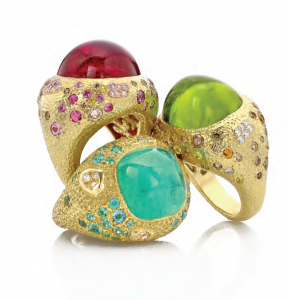 jewelry, this luminescent brooch blossoms with timeless design, creativity, and craftsmanship. So often we go treasure hunting in New York, yet so rarely do we unearth a real treasure. In this case the map couldn’t be marked more clearly. Forego 47th Street. Skip breakfast at Tiffany’s. Wander up Madison Ave. past Chopard and Chanel, and turn east on East 70th Street. Proceed to a cluster of brownstones close to Lexington Avenue. There, tucked behind a gentle garden sits a boite of a jewelry store called Mish New York. For years, my Upper East Side girlfriends have talked in hushed, reverent tones about Mish. They swoon over Mish’s chalcedony and diamond earrings, sigh at the sight of the topaz, gold and diamond pagoda pin and quietly covet the gold Chinese charm bracelet. This eponymous boutique also houses a select array of stunning jewel-encrusted rings, bracelets, necklaces and cufflinks created by Mish Tworkowski, a boyish, friendly former senior VP of Jewelry at Sotheby’s. A New Jersey native, Mish graduated from Rutgers with a double degree in Art History and Business Administration—both of which, no doubt, contributed to his accomplishments as a taste-making jewelry designer and successful entrepreneur. Along with the discerning artistic eye and business acumen, Mish’s interest in jewelry design, its process and art, grew out of an early exposure to all aspects of jewelry making. “A family friend owned a jewelry studio and factory where I would hang out watching the craftsmen at work—creating molds, casting, soldering and polishing silver and gold, and setting stones. It was a fun and amazing place.” Mish explains. “So through osmosis and access to the workshop at a young age, I got to the point where I could make drawings and then
jewelry, this luminescent brooch blossoms with timeless design, creativity, and craftsmanship. So often we go treasure hunting in New York, yet so rarely do we unearth a real treasure. In this case the map couldn’t be marked more clearly. Forego 47th Street. Skip breakfast at Tiffany’s. Wander up Madison Ave. past Chopard and Chanel, and turn east on East 70th Street. Proceed to a cluster of brownstones close to Lexington Avenue. There, tucked behind a gentle garden sits a boite of a jewelry store called Mish New York. For years, my Upper East Side girlfriends have talked in hushed, reverent tones about Mish. They swoon over Mish’s chalcedony and diamond earrings, sigh at the sight of the topaz, gold and diamond pagoda pin and quietly covet the gold Chinese charm bracelet. This eponymous boutique also houses a select array of stunning jewel-encrusted rings, bracelets, necklaces and cufflinks created by Mish Tworkowski, a boyish, friendly former senior VP of Jewelry at Sotheby’s. A New Jersey native, Mish graduated from Rutgers with a double degree in Art History and Business Administration—both of which, no doubt, contributed to his accomplishments as a taste-making jewelry designer and successful entrepreneur. Along with the discerning artistic eye and business acumen, Mish’s interest in jewelry design, its process and art, grew out of an early exposure to all aspects of jewelry making. “A family friend owned a jewelry studio and factory where I would hang out watching the craftsmen at work—creating molds, casting, soldering and polishing silver and gold, and setting stones. It was a fun and amazing place.” Mish explains. “So through osmosis and access to the workshop at a young age, I got to the point where I could make drawings and then 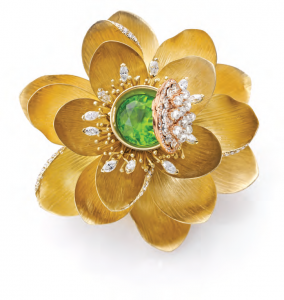 think about how to convert a drawing into a piece of jewelry through, say, the ‘lost-wax’ process.” After college came a 15-year stint at Sotheby’s, which included overseeing the estate sales of Diana Vreeland and Jacqueline Kennedy Onassis. Soon Mish started creating his own line of jewelry. His early business “began organically, as many of my clients at Sotheby’s became friends and were interested in my designs.” He began selling his jewelry on the side with his Sotheby’s boss’s blessings. A self-described “happy workaholic,” Mish threw himself into his dream of opening a shop in 2001. His apprenticeship at Sotheby’s gave Mish some definite thoughts on the subjects of taste and style. To him, they are closely linked. “If you define tasteful and stylish, tasteful could be negative, implying that someone is boring, maybe too solemn or safe in her dress,” he says. “Tasteful and good taste are different. Good taste is always appropriate. Good taste is finely edited, never anything superfluous. Stylish, or having style, is someone who is willing to take a little risk. The little surprise that it gives is always wonderful. It might make you smile. It might make you think, ‘Wow, that person is creative and original.’ When someone is stylish, it is under the veil of appropriateness, there is a tastefulness, but with flair.” Nature is Mish’s primary muse. While at Wakaya, a client’s resort in Fiji, Mish was so blown away by the vibrant colors of sea life that—despite being a self-professed “waterphobic”— donned scuba gear and ventured out to the coral reef. “The colors were awe-inspiring,” Mish recalls. “Huge cobalt-blue starfish, yellow, pink, purple and salmon coral, fish of all colors. I went there to relax, but from the moment I stepped on the island, I was designing jewelry non-stop.”
think about how to convert a drawing into a piece of jewelry through, say, the ‘lost-wax’ process.” After college came a 15-year stint at Sotheby’s, which included overseeing the estate sales of Diana Vreeland and Jacqueline Kennedy Onassis. Soon Mish started creating his own line of jewelry. His early business “began organically, as many of my clients at Sotheby’s became friends and were interested in my designs.” He began selling his jewelry on the side with his Sotheby’s boss’s blessings. A self-described “happy workaholic,” Mish threw himself into his dream of opening a shop in 2001. His apprenticeship at Sotheby’s gave Mish some definite thoughts on the subjects of taste and style. To him, they are closely linked. “If you define tasteful and stylish, tasteful could be negative, implying that someone is boring, maybe too solemn or safe in her dress,” he says. “Tasteful and good taste are different. Good taste is always appropriate. Good taste is finely edited, never anything superfluous. Stylish, or having style, is someone who is willing to take a little risk. The little surprise that it gives is always wonderful. It might make you smile. It might make you think, ‘Wow, that person is creative and original.’ When someone is stylish, it is under the veil of appropriateness, there is a tastefulness, but with flair.” Nature is Mish’s primary muse. While at Wakaya, a client’s resort in Fiji, Mish was so blown away by the vibrant colors of sea life that—despite being a self-professed “waterphobic”— donned scuba gear and ventured out to the coral reef. “The colors were awe-inspiring,” Mish recalls. “Huge cobalt-blue starfish, yellow, pink, purple and salmon coral, fish of all colors. I went there to relax, but from the moment I stepped on the island, I was designing jewelry non-stop.” 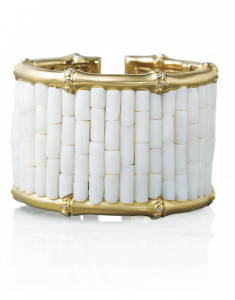 Mish has a devoted following of chic New Yorkers. His wide smile and signature bowties reveal a man confident in his own style, who effortlessly puts people at ease. I recently walked into the cheery shop to find a film crew interviewing Mish for a BIG birthday montage for a regular customer. I heard Mish thank her, teasing that without her enthusiastic patronage, he would “never have been able to buy Karl Lagerfeld’s Paris apartment!” When a museum curator friend heard I was researching this story, she emailed me pictures of her Mish treasures— the “go-to” orbiting pearl earrings, the aquamarine necklace, the Henderson brooch Mish designed for her, which she described as a “stunner on a navy suit jacket…the subtlety of colors shows the eye of the artist.” Even online at 72 dpi, she looked great. “What I love about this jewelry,” she wrote, “is his masterly way of mixing colors, keeping it all fresh and not serious-looking (even if the prices are serious). It’s easy to wear.” Mish enjoys collaborating with his customers and being inspired by their lives and interests. His playful wit emerged when designing cuff links and tuxedo studs for a client’s husband’s 50th birthday. The husband collected cars and especially loved his Aston-Martin. Mish made studs, using photos the wife took, that were replicas of the wheels (replete with gemstone hubcaps). He backed the cuff links with miniature gold versions of Aston-Martin tire treads. “What is special about coming to someone like me is that I’m not wholesaling, but dealing one-on-one with the client with a defined style,” Mish explains. “Many jewelers have globalized, so that you can buy their jewelry in any city or country and so can your friends. If you want to buy my designs or find something unique that none of your friends have, you have to come to my store.” In a world where so much is mass-produced, impersonal and brazenly marketed, it is rare to come across a business that thrives on artistry, workmanship and word of mouth. We sometimes forget that, in matters of the heart, a gulf still separates the ordinary from the extraordinary. Mish is a reminder of just how wide that gulf can be. EDGE
Mish has a devoted following of chic New Yorkers. His wide smile and signature bowties reveal a man confident in his own style, who effortlessly puts people at ease. I recently walked into the cheery shop to find a film crew interviewing Mish for a BIG birthday montage for a regular customer. I heard Mish thank her, teasing that without her enthusiastic patronage, he would “never have been able to buy Karl Lagerfeld’s Paris apartment!” When a museum curator friend heard I was researching this story, she emailed me pictures of her Mish treasures— the “go-to” orbiting pearl earrings, the aquamarine necklace, the Henderson brooch Mish designed for her, which she described as a “stunner on a navy suit jacket…the subtlety of colors shows the eye of the artist.” Even online at 72 dpi, she looked great. “What I love about this jewelry,” she wrote, “is his masterly way of mixing colors, keeping it all fresh and not serious-looking (even if the prices are serious). It’s easy to wear.” Mish enjoys collaborating with his customers and being inspired by their lives and interests. His playful wit emerged when designing cuff links and tuxedo studs for a client’s husband’s 50th birthday. The husband collected cars and especially loved his Aston-Martin. Mish made studs, using photos the wife took, that were replicas of the wheels (replete with gemstone hubcaps). He backed the cuff links with miniature gold versions of Aston-Martin tire treads. “What is special about coming to someone like me is that I’m not wholesaling, but dealing one-on-one with the client with a defined style,” Mish explains. “Many jewelers have globalized, so that you can buy their jewelry in any city or country and so can your friends. If you want to buy my designs or find something unique that none of your friends have, you have to come to my store.” In a world where so much is mass-produced, impersonal and brazenly marketed, it is rare to come across a business that thrives on artistry, workmanship and word of mouth. We sometimes forget that, in matters of the heart, a gulf still separates the ordinary from the extraordinary. Mish is a reminder of just how wide that gulf can be. EDGE
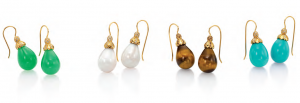
All photos courtesy of Mish New York; special thanks to Michael Oldford
A New Jersey attorney inspires a hit TV series
Thanks to Nelson Johnson, you’ll never look at Atlantic City the same way again. The attorney for the Atlantic City Planning Board during the casino boom of the early 1980s, Johnson was inspired to write about the history of the town that began as a tranquil seaside health resort and became a playground for the mob. His research resulted in a book entitled Boardwalk Empire: The Birth, High Times, and Corruption of Atlantic City (Plexus Publishing, $16.95)—and provided the inspiration for HBO’s critically acclaimed series Boardwalk Empire. Prior to Boardwalk Empire, Nelson’s name was unknown in the literary world. However, no author in the Garden State is more qualified to write with authority on matters of crime and punishment in AC. The Hammonton resident just happens to be a Superior Court Judge in Atlantic County. Judge Johnson’s book is the result of two decades of research, dozens of eyewitness interviews and extensive fact- checking. Boardwalk Empire chronicles the highlights and lowlights of the corrupt politicians who came to rule Atlantic City when the town’s sole purpose was providing a good time to its visitors (legally or not). Nucky Thompson, played by Steve Buscemi, is based on Nucky Johnson, the second of three bosses to lead the political machine that dominated city politics, funded by payoffs from bars, brothels, and bootlegging. The real-life Nucky ruled the town for three decades starting in the years prior to World War I. When the author’s manuscript (originally dubbed “Nucky’s Town”) found its way into the hands of John Bryans at Plexus nearly a decade ago, the publisher knew it would sell based on the company’s success with similar regional projects. Johnson always believed it could be more, despite fruitless trips to Hollywood to pitch the story as a feature film or documentary. Fortunately, Johnson did catch the attention of an agent, and in 2006 Bryans received an e-mail from an HBO television executive who was salivating for the rights to a book revolving around shocking backdoor politics, explosive violence, and fatal power struggles. The HBO series debuted on September 19th, 2010, starring Buscemi, Michael Pitt and Kelly Macdonald. The show features the creative talents of Terence Winter, writer on The Sopranos, and Mark Wahlberg as producer; Martin Scorsese directed the first episode. Winter also penned the foreword for the new edition of the book. As a sitting judge, the author has backed away from interviews publicizing the book or the HBO series. However, according to Bryans, upon initial publication, Boardwalk Empire sold roughly 10,000 copies. Thanks to the buzz created by HBO, another 10,000 flew off the shelves. An order for another 85,000 copies, updated to be a tie-in edition, followed. The book concerns itself with a much broader sweep of material than the more narrowly focused series, which, as Bryans points out, focuses on “sex, violence, and swearing.” That being said, the seedy underbelly of Atlantic City is fully exposed in Johnson’s book—often with the aid of stunningly blunt first-person accounts. As one mob connected interview subject observed, “If the people who came to town had wanted Bible readings, we’d have given ’em that…they wanted booze, broads and gambling, so that’s what we gave ’em.” Regarding the HBO series, Bryans has liked what he sees on the small screen. “The show helps you realize that Nucky is a complex, fascinating character, and one you love to hate,” he says. “It’s nice to see that people are open to shades of gray.” “If you delve into the history of any major city in New Jersey,” Bryans maintains, “you’ll probably find the basis for a book. I think Boardwalk Empire makes everyone start thinking about the birth of their own hometown.” EDGE
checking. Boardwalk Empire chronicles the highlights and lowlights of the corrupt politicians who came to rule Atlantic City when the town’s sole purpose was providing a good time to its visitors (legally or not). Nucky Thompson, played by Steve Buscemi, is based on Nucky Johnson, the second of three bosses to lead the political machine that dominated city politics, funded by payoffs from bars, brothels, and bootlegging. The real-life Nucky ruled the town for three decades starting in the years prior to World War I. When the author’s manuscript (originally dubbed “Nucky’s Town”) found its way into the hands of John Bryans at Plexus nearly a decade ago, the publisher knew it would sell based on the company’s success with similar regional projects. Johnson always believed it could be more, despite fruitless trips to Hollywood to pitch the story as a feature film or documentary. Fortunately, Johnson did catch the attention of an agent, and in 2006 Bryans received an e-mail from an HBO television executive who was salivating for the rights to a book revolving around shocking backdoor politics, explosive violence, and fatal power struggles. The HBO series debuted on September 19th, 2010, starring Buscemi, Michael Pitt and Kelly Macdonald. The show features the creative talents of Terence Winter, writer on The Sopranos, and Mark Wahlberg as producer; Martin Scorsese directed the first episode. Winter also penned the foreword for the new edition of the book. As a sitting judge, the author has backed away from interviews publicizing the book or the HBO series. However, according to Bryans, upon initial publication, Boardwalk Empire sold roughly 10,000 copies. Thanks to the buzz created by HBO, another 10,000 flew off the shelves. An order for another 85,000 copies, updated to be a tie-in edition, followed. The book concerns itself with a much broader sweep of material than the more narrowly focused series, which, as Bryans points out, focuses on “sex, violence, and swearing.” That being said, the seedy underbelly of Atlantic City is fully exposed in Johnson’s book—often with the aid of stunningly blunt first-person accounts. As one mob connected interview subject observed, “If the people who came to town had wanted Bible readings, we’d have given ’em that…they wanted booze, broads and gambling, so that’s what we gave ’em.” Regarding the HBO series, Bryans has liked what he sees on the small screen. “The show helps you realize that Nucky is a complex, fascinating character, and one you love to hate,” he says. “It’s nice to see that people are open to shades of gray.” “If you delve into the history of any major city in New Jersey,” Bryans maintains, “you’ll probably find the basis for a book. I think Boardwalk Empire makes everyone start thinking about the birth of their own hometown.” EDGE
Editor’s Note: Boardwalk Empire (the series) was renewed for a second season just 48 hours after it debuted on HBO. For more information on Judge Johnson and Boardwalk Empire (the book) log onto boardwalkempire.com. Johnson has already begun work on his next book, The Northside: African Americans and the Creation of Atlantic City.
Feel like strangling Santa? You’re not alone. And there’s probably nothing wrong with you, either.
Tradition tells us that this time of year is meant for “Decking the Halls.” But did you ever feel like decking a friend or family member instead? All kidding aside,  the mini-bouts of depression and anger that sometimes accompany this season are very real. The holiday blues can grip even the happiest, most well-adjusted of us with little or no warning. Understanding where these feelings come from, as well as your options for addressing them, can go a long way toward making it to January with your sanity intact. According to Dr. Rodger Goddard, who has served as Chief Psychologist at Trinitas Regional Medical Center for more than two decades, stress is almost always the trigger. And holiday stress can come from many sources. “At the end of the year, during the holidays, we reflect on our lives,” he explains. “When we reflect, we can get nervous about many things. For instance, many of us now face intense financial stress due to the state of the economy. This kind of reflection often leads us to dwell on our shortcomings and what we don’t have, rather than our accomplishments and the miracle of just being alive.” Dealing with relatives can just compound the situation. Tension between different family members, dwelling on past hurts or injustices, rivalries and jealousies can bring old wounds back to the surface. In this environment, little things—such as where to eat, what to eat and who sits where—can become incredibly stressful and suck the joy out of what should be pleasant reconnections and reunions. “On top of this,” Dr. Goddard adds, “we often eat and drink too much. The result is body discomfort, which contributes to distressing emotions.” The media can play a leading role in feelings of depression and anger. Movies, music, television shows and commercials all make the holidays out to be a magical time of happiness and perfection. To feel otherwise just feels wrong. “We live in reality, not a movie,” says Dr. Goddard. “Holidays cramp our schedule—overloading us with shopping, socializing, preparations and party-going. The holiday season has become hyper-commercialized, giving us the message that love is shown through material gift-giving. Under these conditions, we can feel that what we give and what we get are being constantly evaluated—which leads to even more stress.”
the mini-bouts of depression and anger that sometimes accompany this season are very real. The holiday blues can grip even the happiest, most well-adjusted of us with little or no warning. Understanding where these feelings come from, as well as your options for addressing them, can go a long way toward making it to January with your sanity intact. According to Dr. Rodger Goddard, who has served as Chief Psychologist at Trinitas Regional Medical Center for more than two decades, stress is almost always the trigger. And holiday stress can come from many sources. “At the end of the year, during the holidays, we reflect on our lives,” he explains. “When we reflect, we can get nervous about many things. For instance, many of us now face intense financial stress due to the state of the economy. This kind of reflection often leads us to dwell on our shortcomings and what we don’t have, rather than our accomplishments and the miracle of just being alive.” Dealing with relatives can just compound the situation. Tension between different family members, dwelling on past hurts or injustices, rivalries and jealousies can bring old wounds back to the surface. In this environment, little things—such as where to eat, what to eat and who sits where—can become incredibly stressful and suck the joy out of what should be pleasant reconnections and reunions. “On top of this,” Dr. Goddard adds, “we often eat and drink too much. The result is body discomfort, which contributes to distressing emotions.” The media can play a leading role in feelings of depression and anger. Movies, music, television shows and commercials all make the holidays out to be a magical time of happiness and perfection. To feel otherwise just feels wrong. “We live in reality, not a movie,” says Dr. Goddard. “Holidays cramp our schedule—overloading us with shopping, socializing, preparations and party-going. The holiday season has become hyper-commercialized, giving us the message that love is shown through material gift-giving. Under these conditions, we can feel that what we give and what we get are being constantly evaluated—which leads to even more stress.”
Mind-Heart-Body-Soul So what’s a seasonal sour-puss to do? Creating a “radical support” plan for the holidays should alleviate a good deal of the stress.  According to Dr. Goddard, your anti-stress strategy should look something like this:
According to Dr. Goddard, your anti-stress strategy should look something like this:
MIND — Make a PIPS list (Problem Identification/Problem Solving); for each thing that worries you about the holidays, write down a reasonable solution.
HEART — Spell out the actions that you will take to protect yourself and nurture yourself emotionally—specifically, commit to do the things that you love doing, with the people that you love the most.
BODY — Formulate a plan to limit your intake of the things that are great in moderation, but make you feel lousy in excess: sugar, starch, desserts, alcohol, cholesterol—you know, all the good stuff. Also, write down a daily workout regimen and stick to it. Exercise and movement actually processes negative emotions out of the body.
SOUL — Spell out your life mission and purpose. List the good things you have achieved during the past year. Look toward the year ahead and identify what you will do to experience a deeper spiritual feeling—anything from connecting with nature to taking a Tai Chi class. “We all try very hard to make life work,” says Dr. Goddard. “Always remember that you deserve the best.” EDGE
Editor’s Note: Dr. Goddard also directs Trinitas’s Wellness Management Services, which provides training, consultation and program development to companies and schools to improve employee, teacher and corporate health, effectiveness and success.
